Complete Solutions to Example of chapter LAWS OF MOTION of Class 11 book with complete answers and questions
| Class 11 | PHYSICS |
| Chapter | LAWS OF MOTION |
| DC PANDEY | Example |
| Number Of Questions | 86 |
| Academic Year | 2023-24 |
A cylinder of weight `W` is resting on a V-groove as shown in figure .Draw its free body diagram.
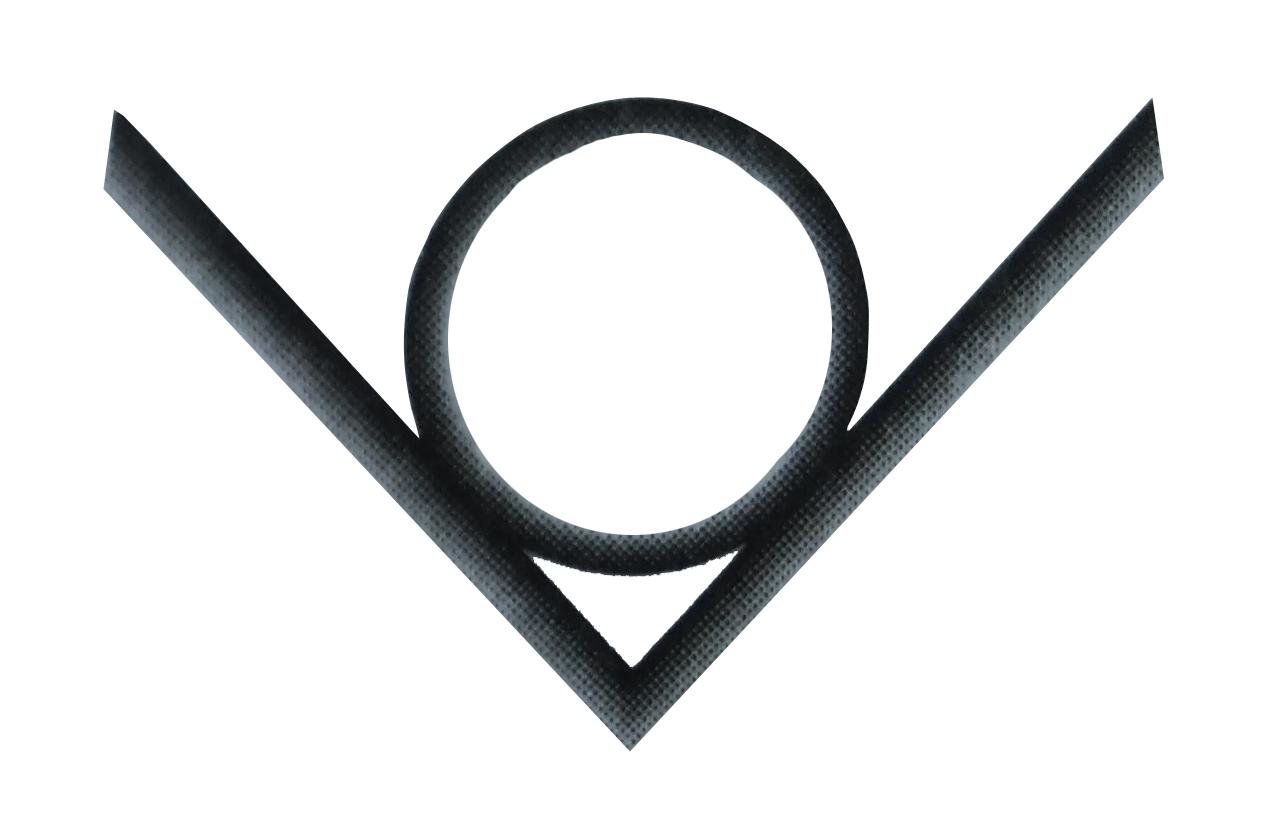
View SolutionThree blocked `A,B` and `C` are placed one over the other as shown in figure. Draw free body diagram of all the three blocks.
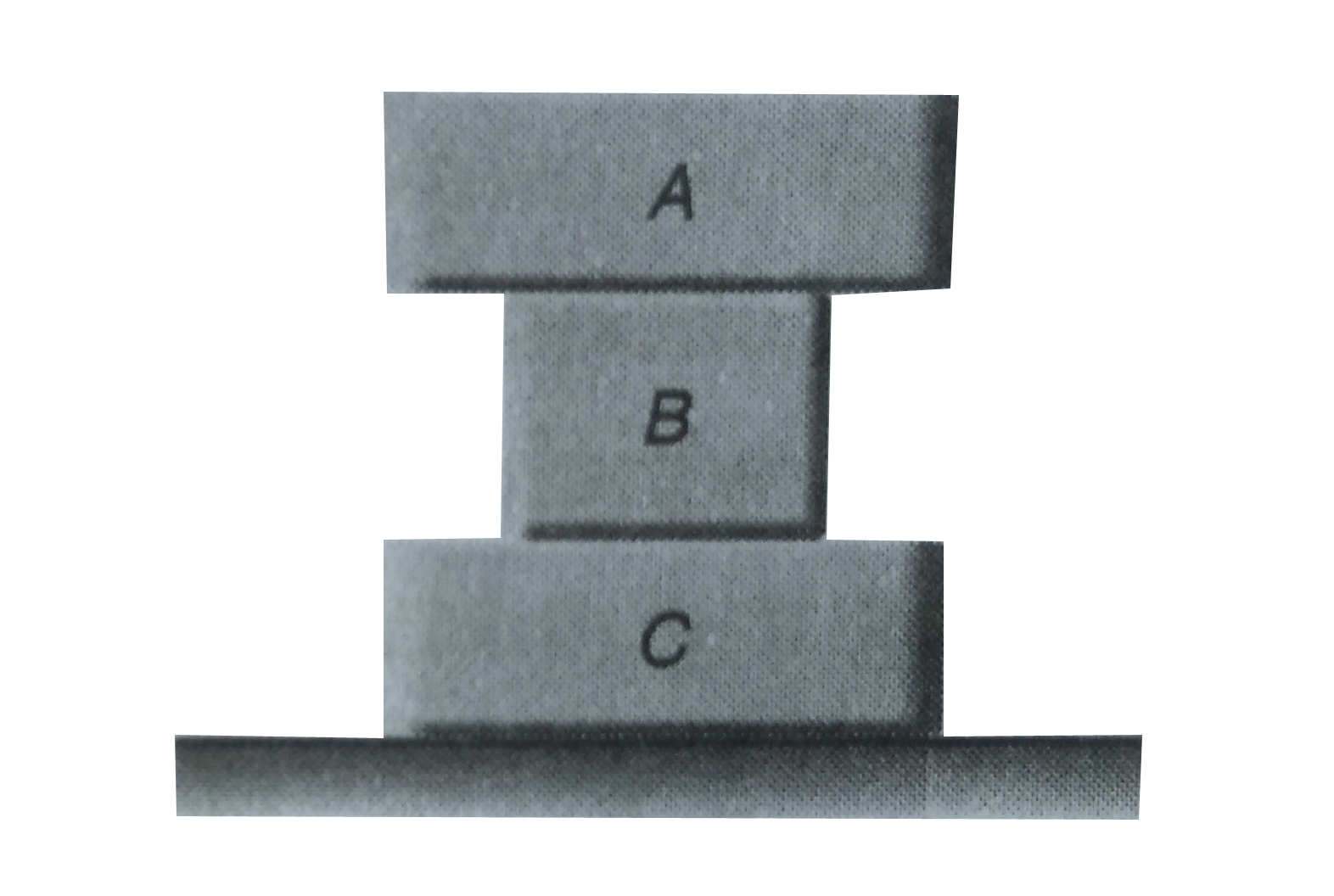
View SolutionA blocked of mass `m` is attached with two strings as shown in figure .Draw the free body diagram of the block.
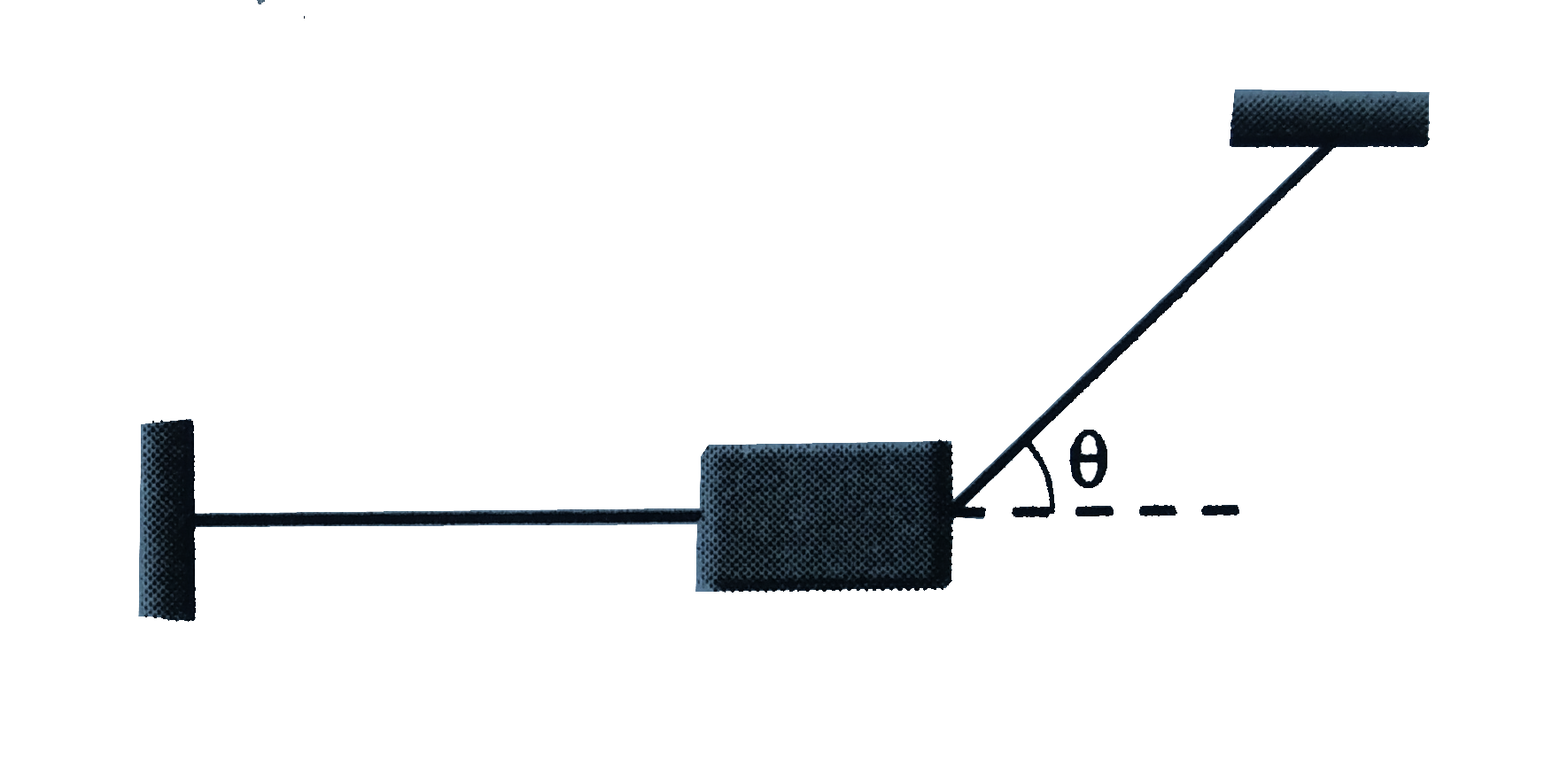
View SolutionResolve a weight of 10 N in two directions which are parallel and perpendicular to a slope inclined at `30^(@)` to the horizontal.
View SolutionResolve horizontally and vertically a force `F= 8N` which moves an angle of `45^(@)` with the horizontal.
View SolutionA body is supported on a rought plane inclined at `30^(@)` to the horizontal by a string attached to the body and held at an angle of `30^(@)` to the plane . Draw a diagram showing the forces acting on the body and resolve each of these forces
(a) horizontally and vertically,
(b) parallel and perpendicular to the plane.
View Solution`A` rod `AB` rests with the end `A` on rough horizontal ground and the end `B` against a smooth vertical wall. The rod is uniform and of weight w. If the rod is in equilibrium in the position shown in figure.Find
(a)frictional shown at `A`
(b) normal reaction at `A`
(c) normal reaction at `B`.
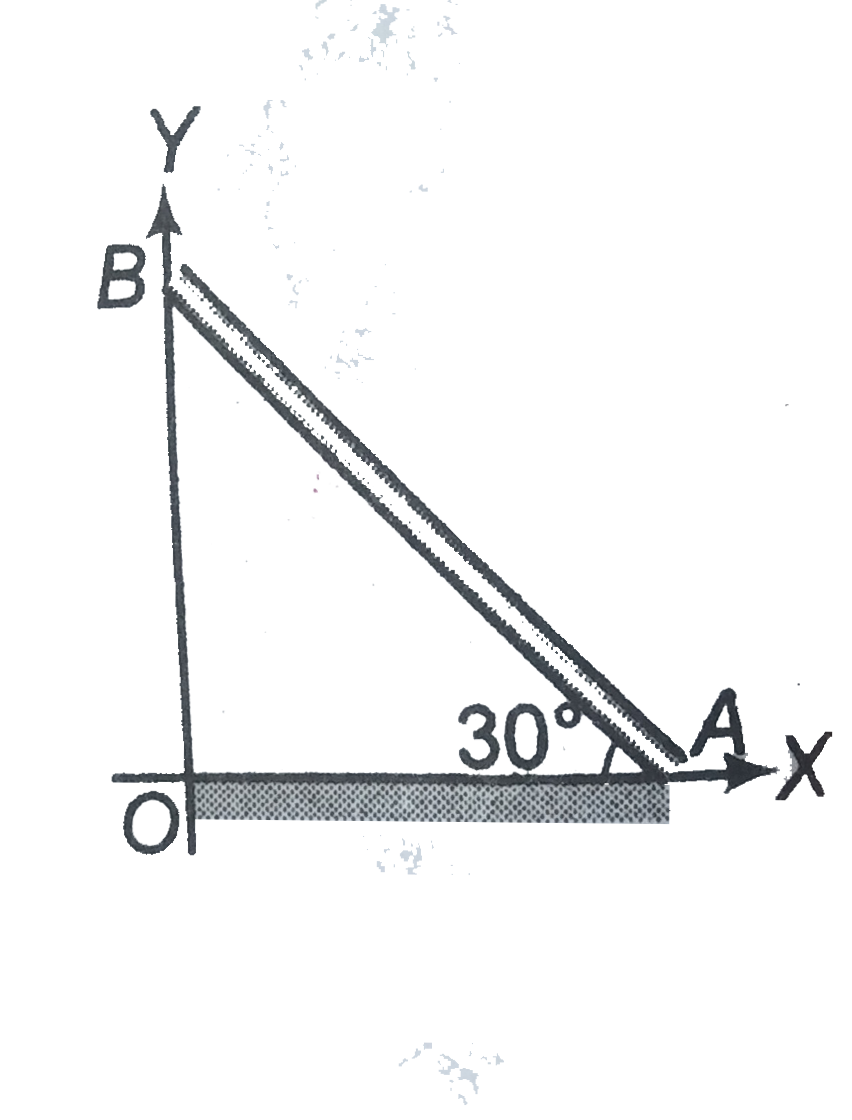
View SolutionAn object is in equilibrium under four concurrent forces in the direction shown in figure. Find the magnitudes of `F_(1)` and `F_(2)`
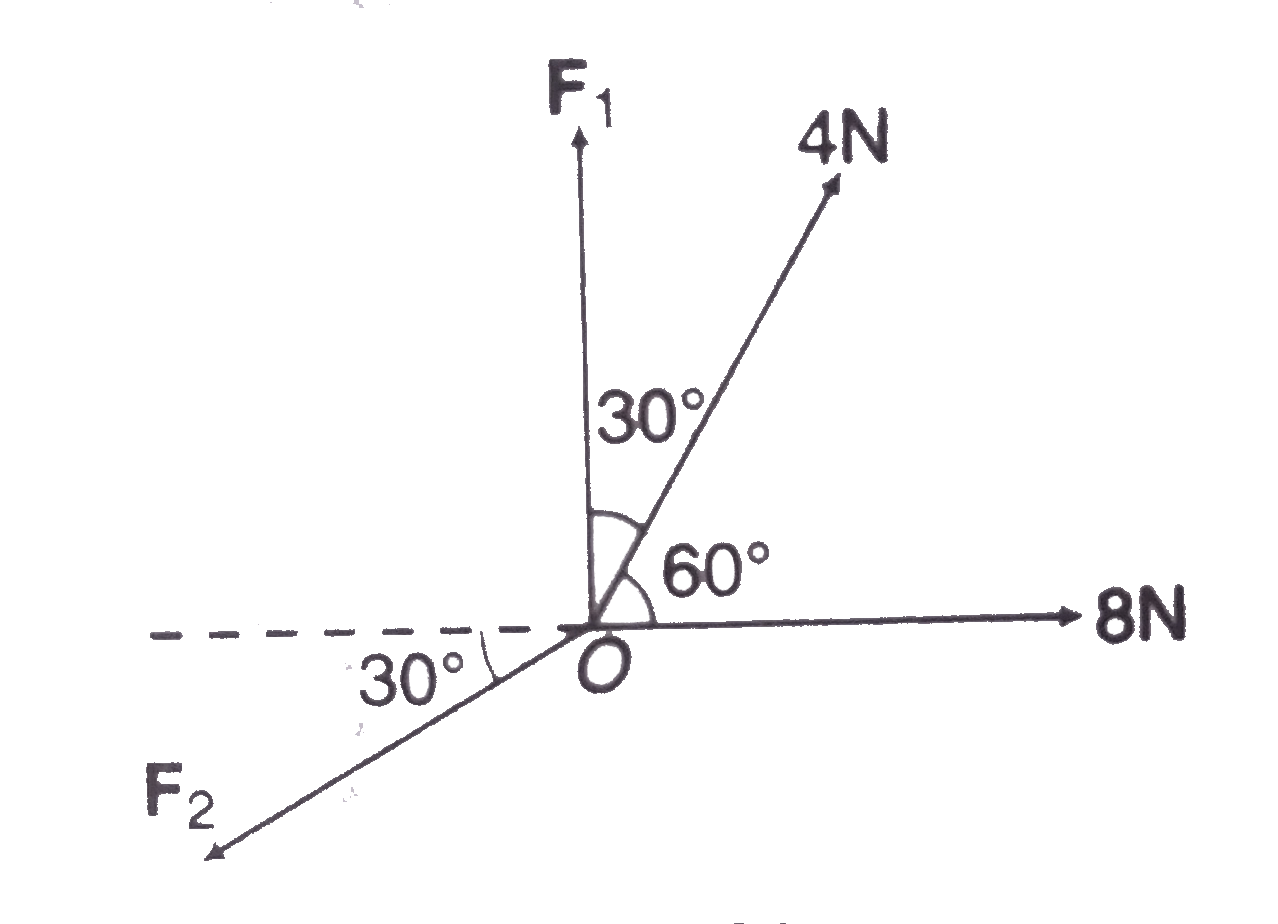
View SolutionOne end of a string `0.5 m` long is fixed to a point `A` and the other end is fastened to a small object of weight `8 N`. The object is pulled aside by a horizontal force F, until it is` 0.3 m` from the vertical through `A`.Find the magnitudes of the tension `T` in the string and force `F`.
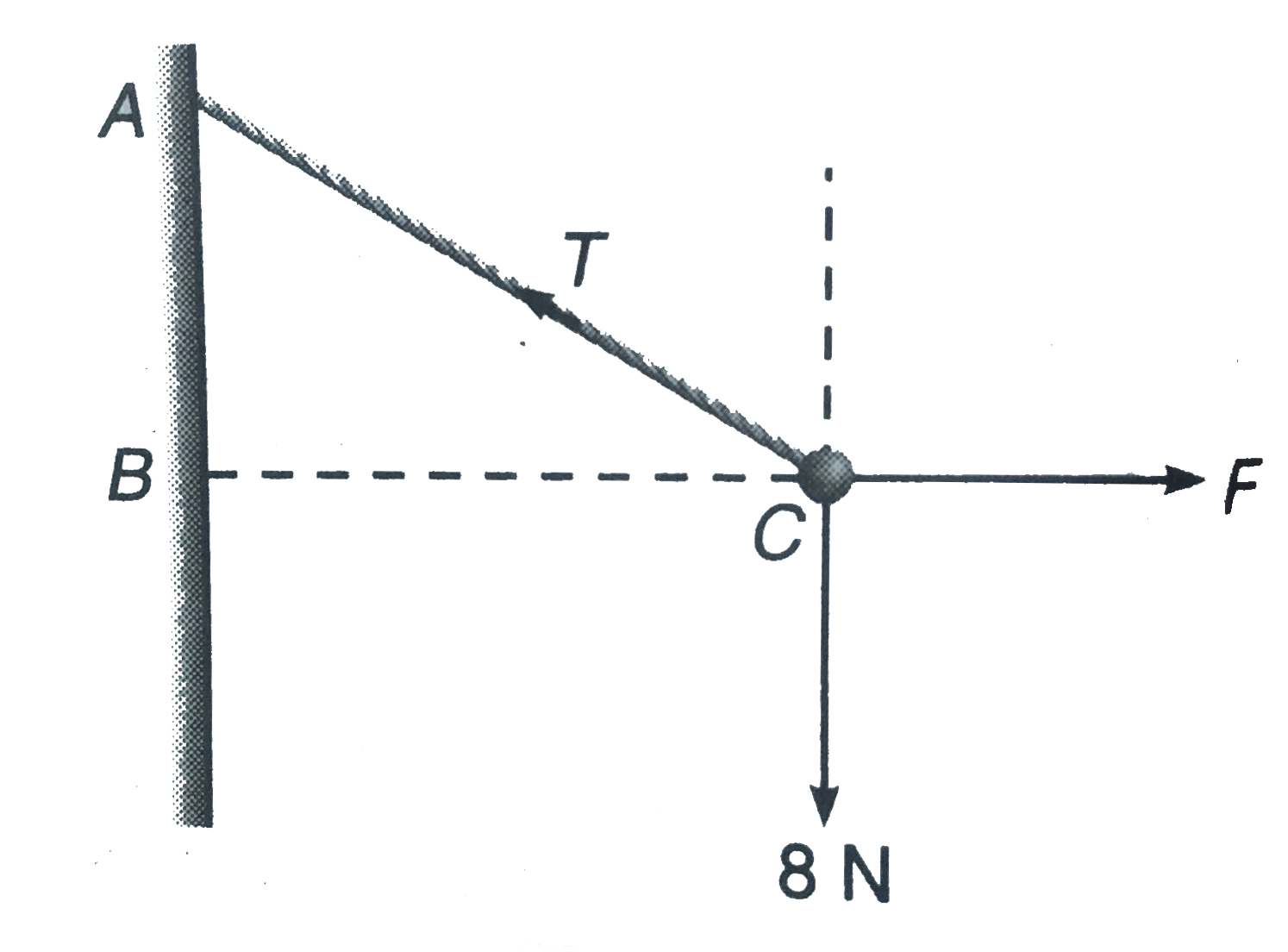
View SolutionThe rod shown in figure has a mass of `2kg` and length `4m`. In equilibrium, find the hinge force (or its two component) acting on the rod and tension in the string. Tage `g=10 m//s^(2) , sin37^(@) = (3)/(5)` and `cos 37^(@)=(4)/(5)`
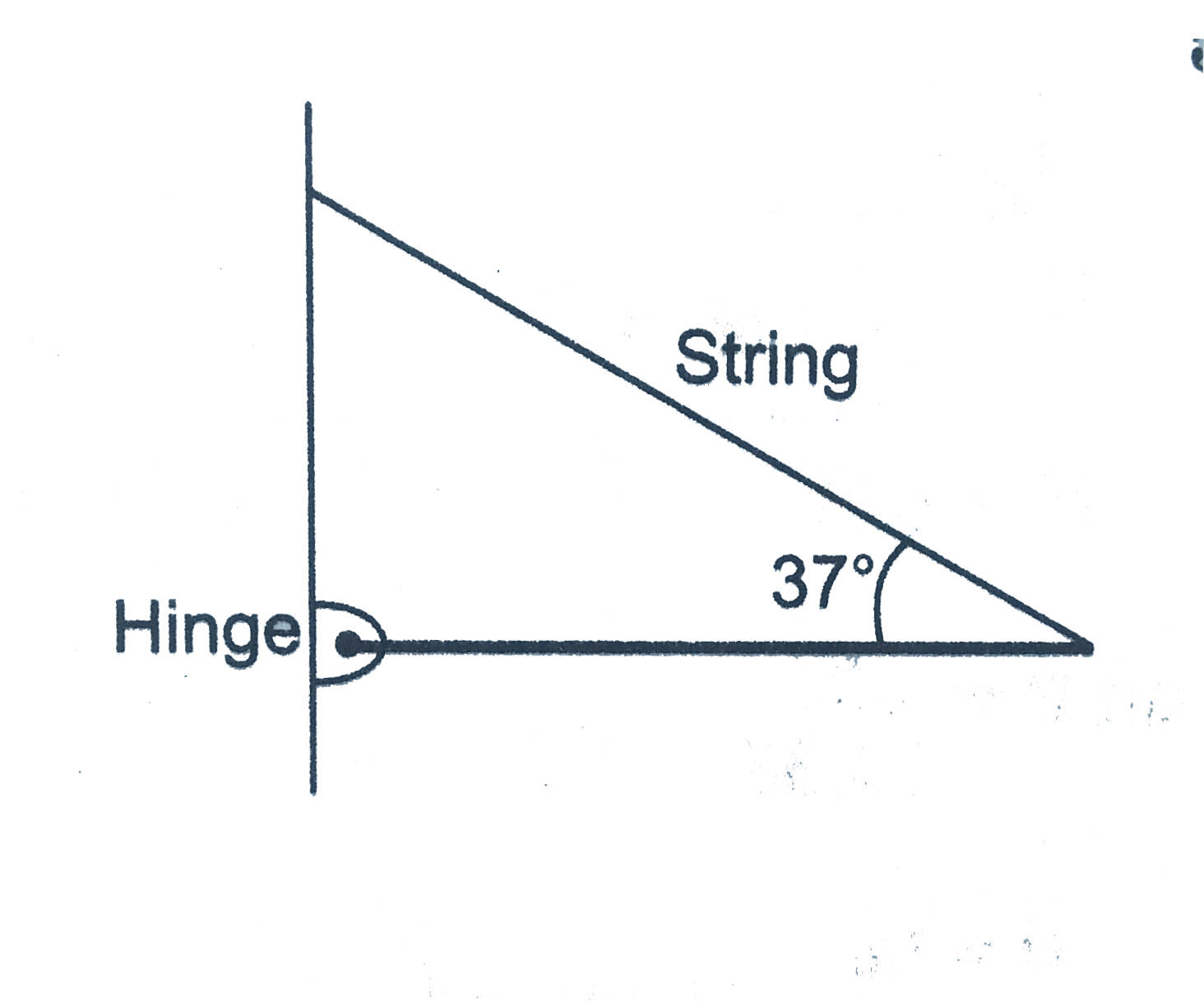
View SolutionTwo blocks of masses `4kg` and `2kg` are placed side on a smooth horizontal surface as shown in the figure. A horizontal force of `20N` is applied on `4kg `block. Find
(a) the acceleration of each block.
(b) the normal reaction between two blocks.
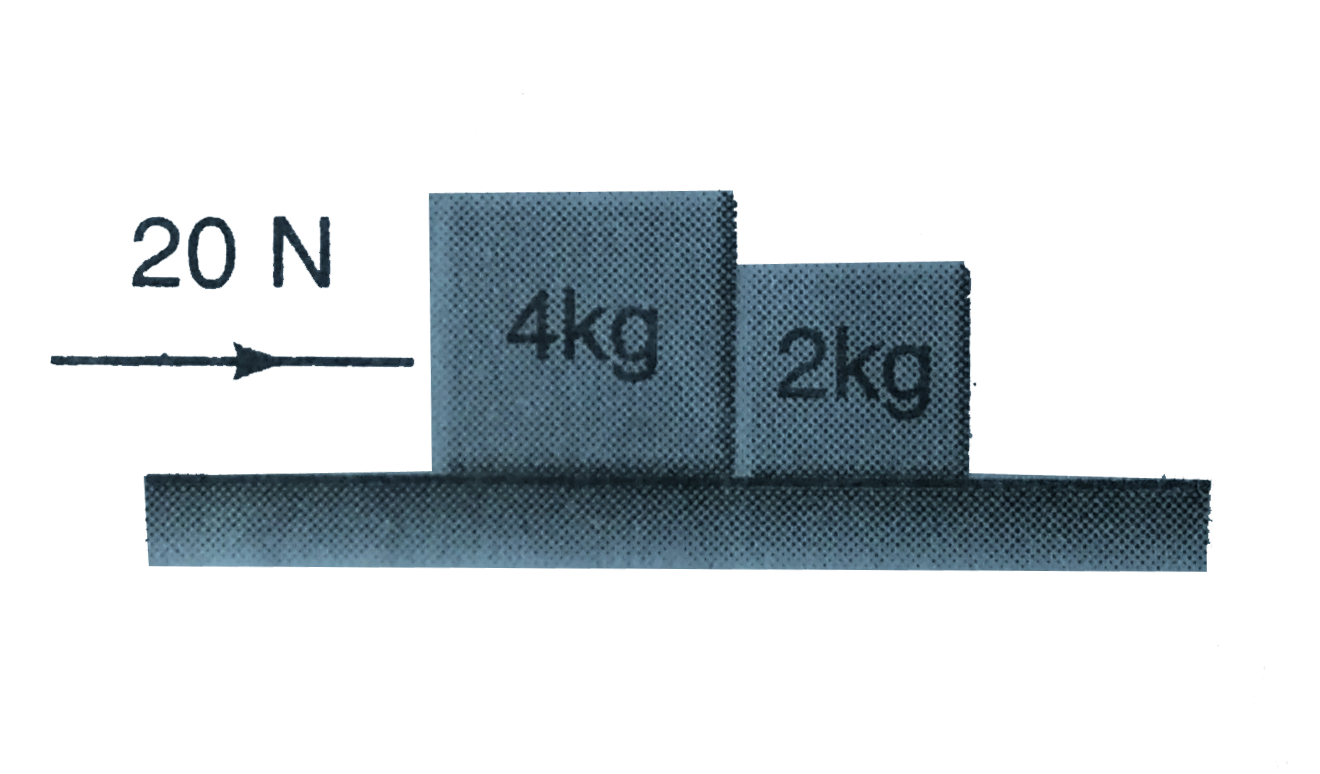
View SolutionThree blocks of masses `3kg ,2kg` and `1kg` are placed side by side on a smooth surface as shown in figure. A horizontal force of `12N` is applied on `3kg` block. Find the net force on `2kg` block.
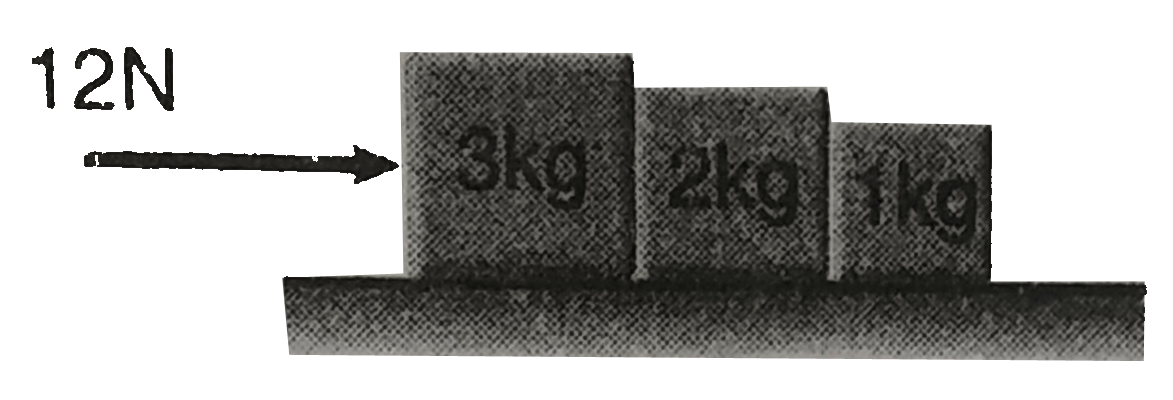
View SolutionIn the arrangement shown in figure. The strings are light and inextensible. The surface over which block are placed is smooth.Find
(a) the acceleration of each block,
(b) the tension in each string.

View SolutionTwo block of mass 4 kg and 2 kg are attached by an inextensible light string as shown in figure. Both the blocks are pulled vertically upwards by a force F=120N
Find
(a) the acceleration of the blocks
(b) tension in the string. (Take g=`10 ms^(-2)`)
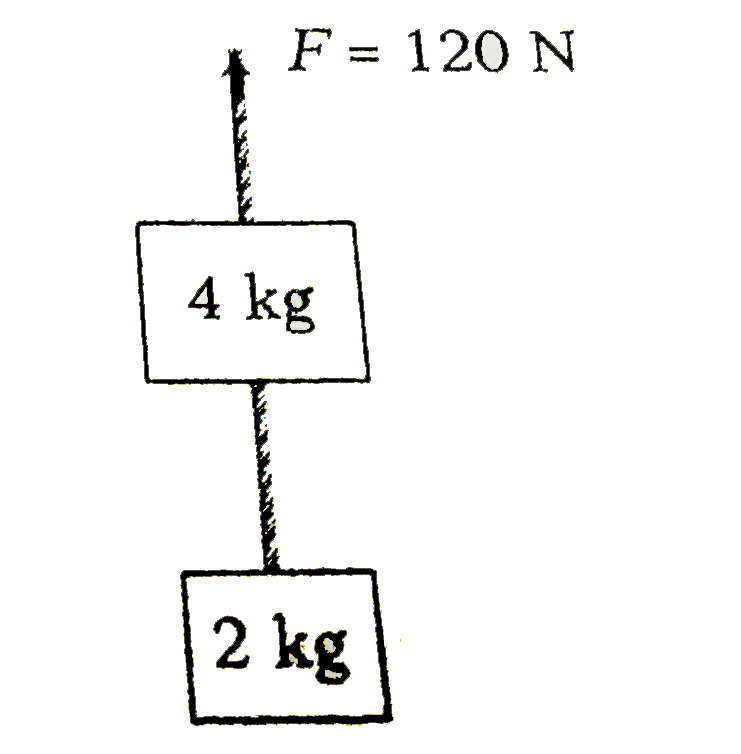
View SolutionIn the system shown in figure pully is smooth. Strings is massless and inextensible.Find acceleration of the system a, tension `T_(1)` and`T_(2)` `(g=10m//s^(2))`
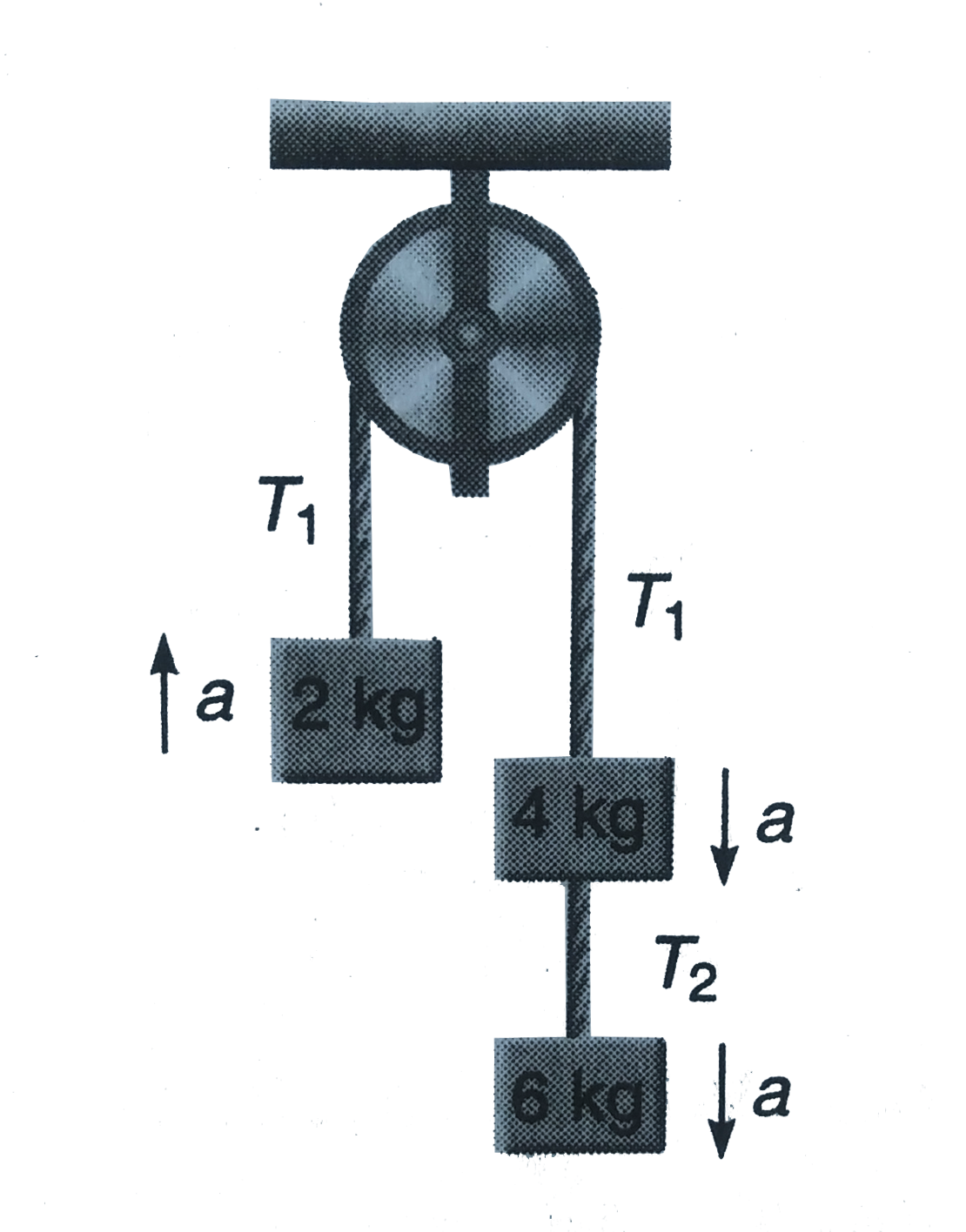
View SolutionIn the system shown in figure all surfaces are smooth. Strings is massless and inextensible.Find acceleration of the system and tension `T` in the string `(g=10m//s^(2))`
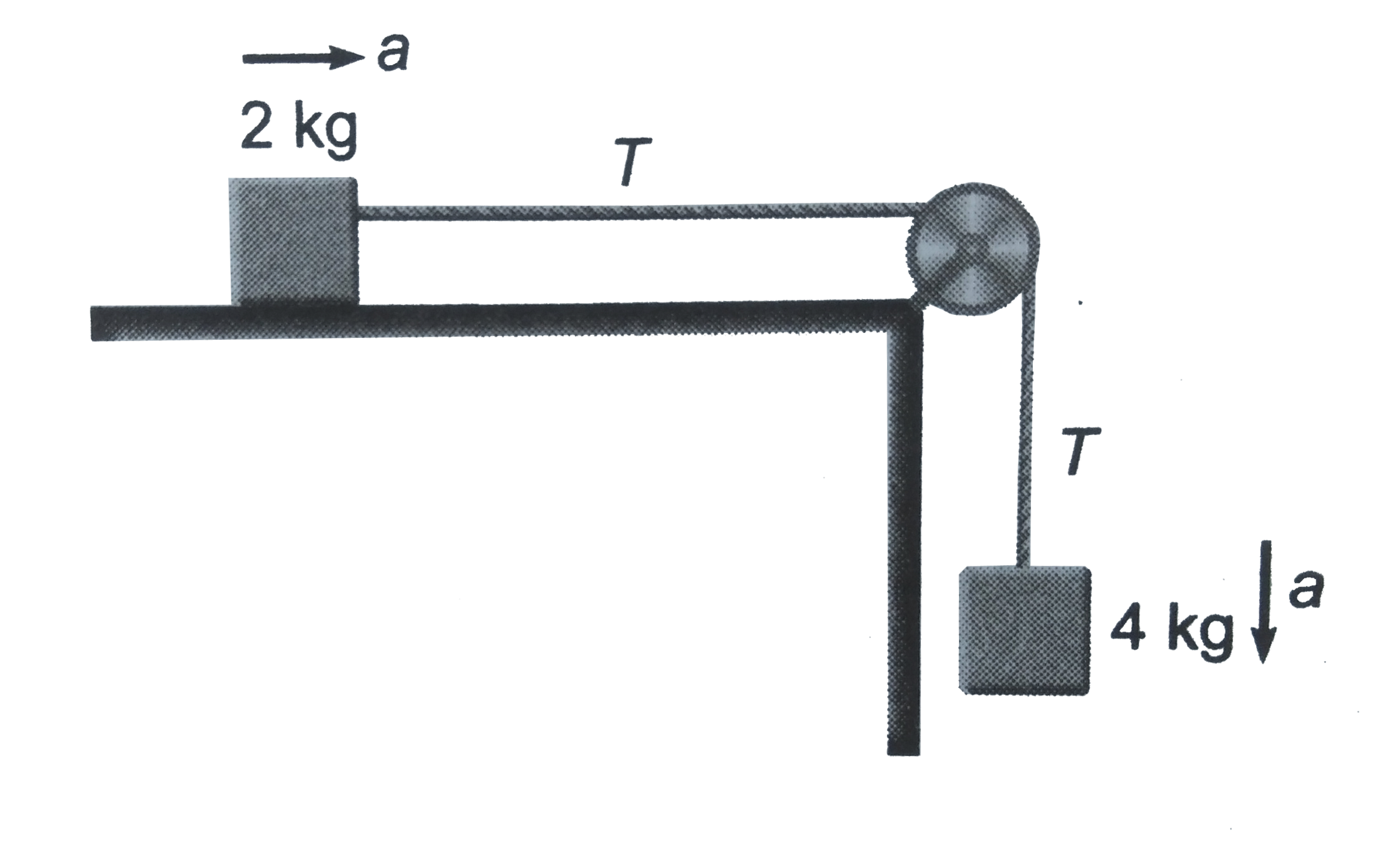
View SolutionIn the adjacent figure, masses of `A,B` and `C` are `1kg ,3kg` and `2kg` respectively. Find
(a) the acceleration of the system and
(b) tension in the strings.
Neglect friction.`(g=10m//s^(2))`
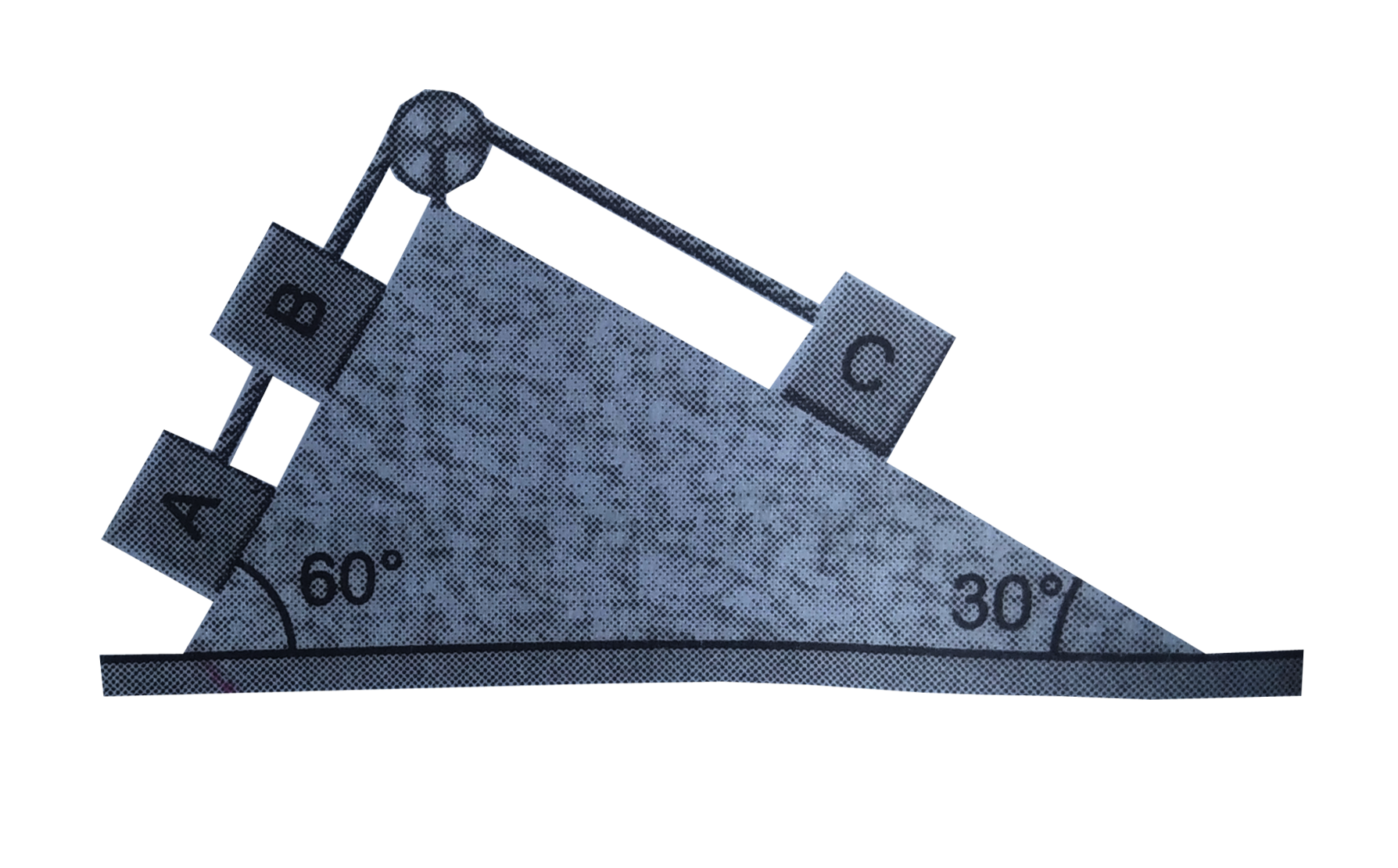
View SolutionUsing constraint method find the relation between accelerations of `1` and `2`.
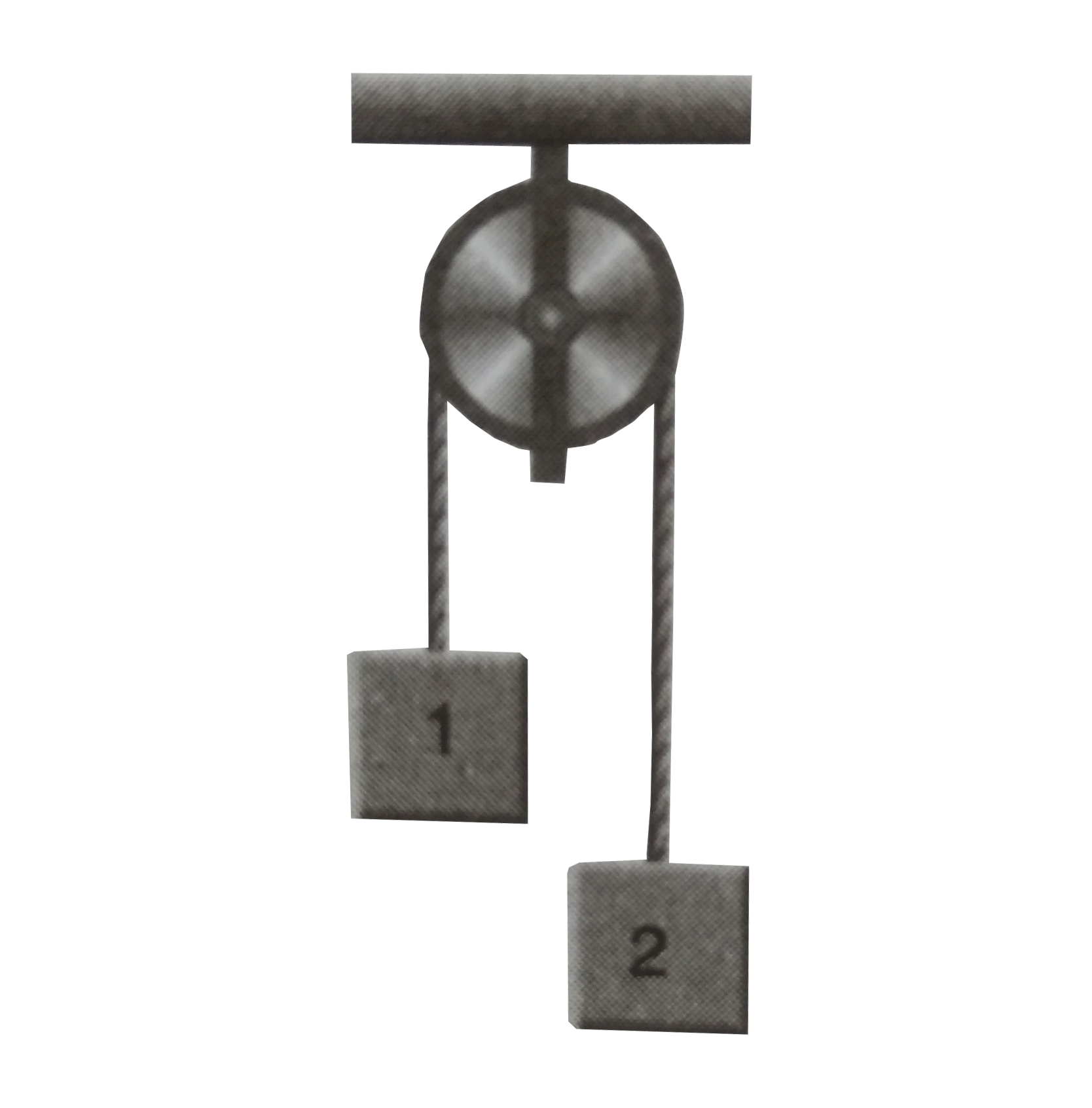
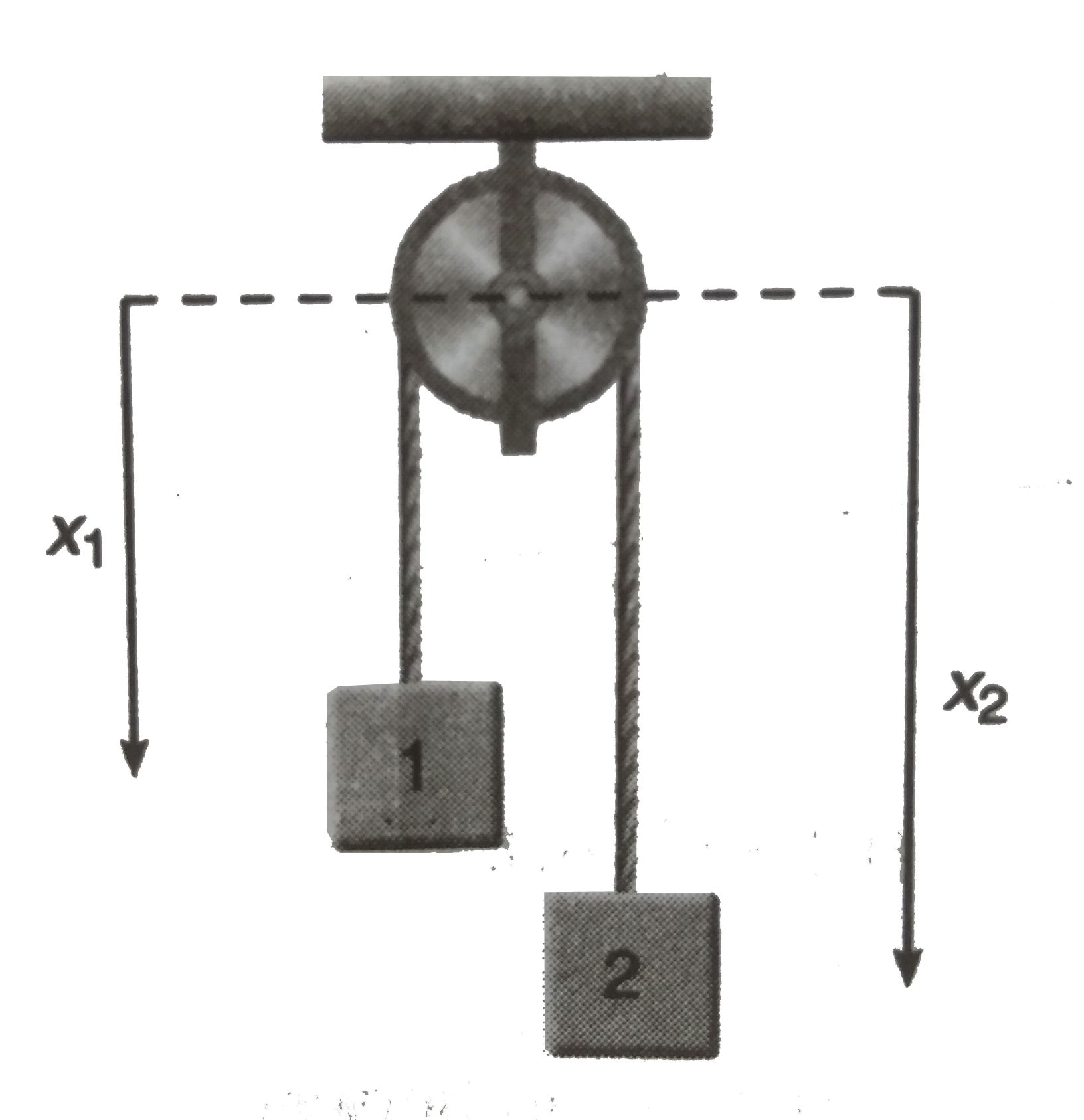
View SolutionUsing constraint method find the relation between of `a_(1)` and `a_ (2)`.
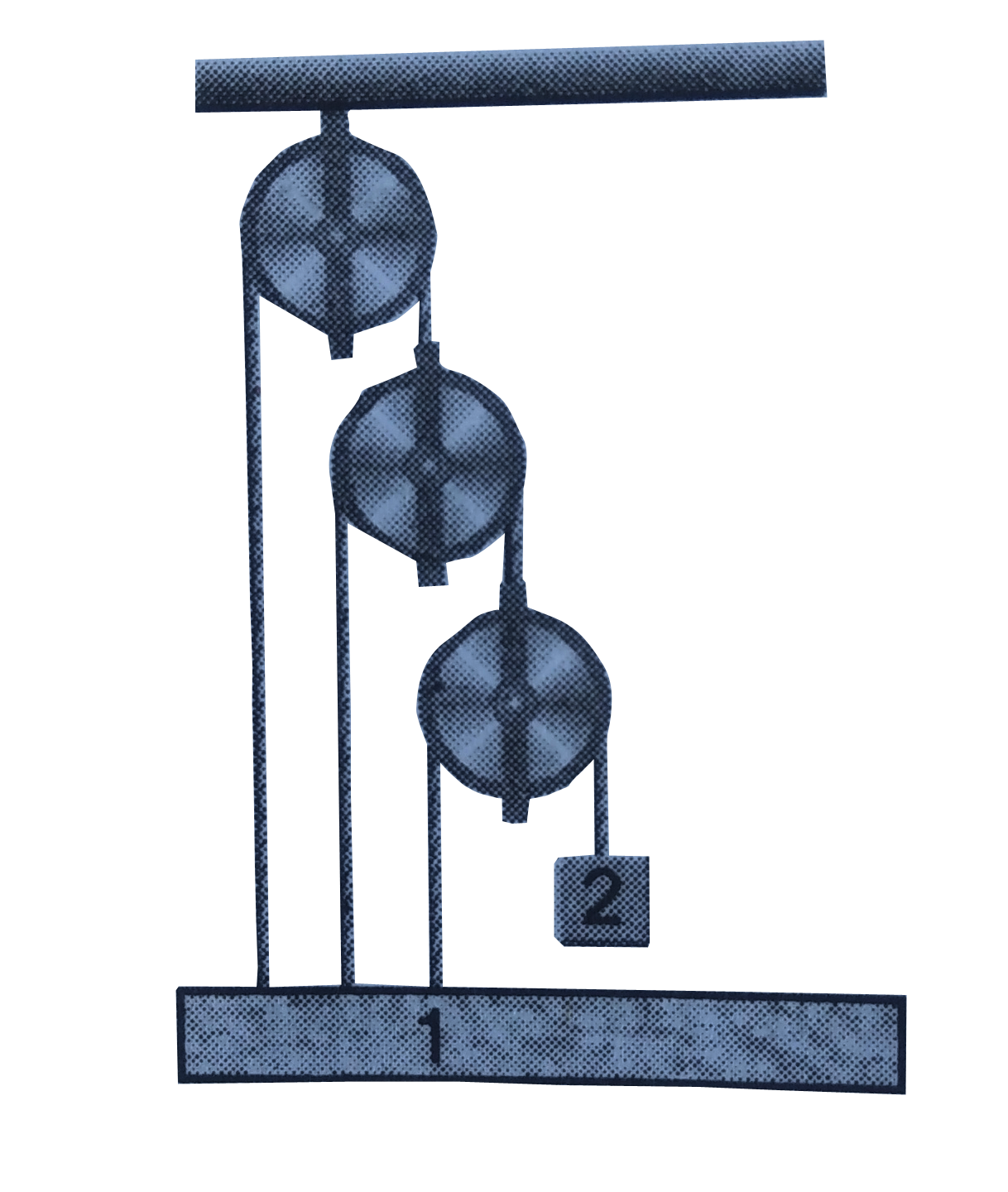
View SolutionIn the above example, if two blocks have masses `1kg` and `2kg` respectively then find their acceleration and tension in different string.
View SolutionThe system shown in figure is released is released from rest . Find acceleration of different string blocks and tenson in different strings.
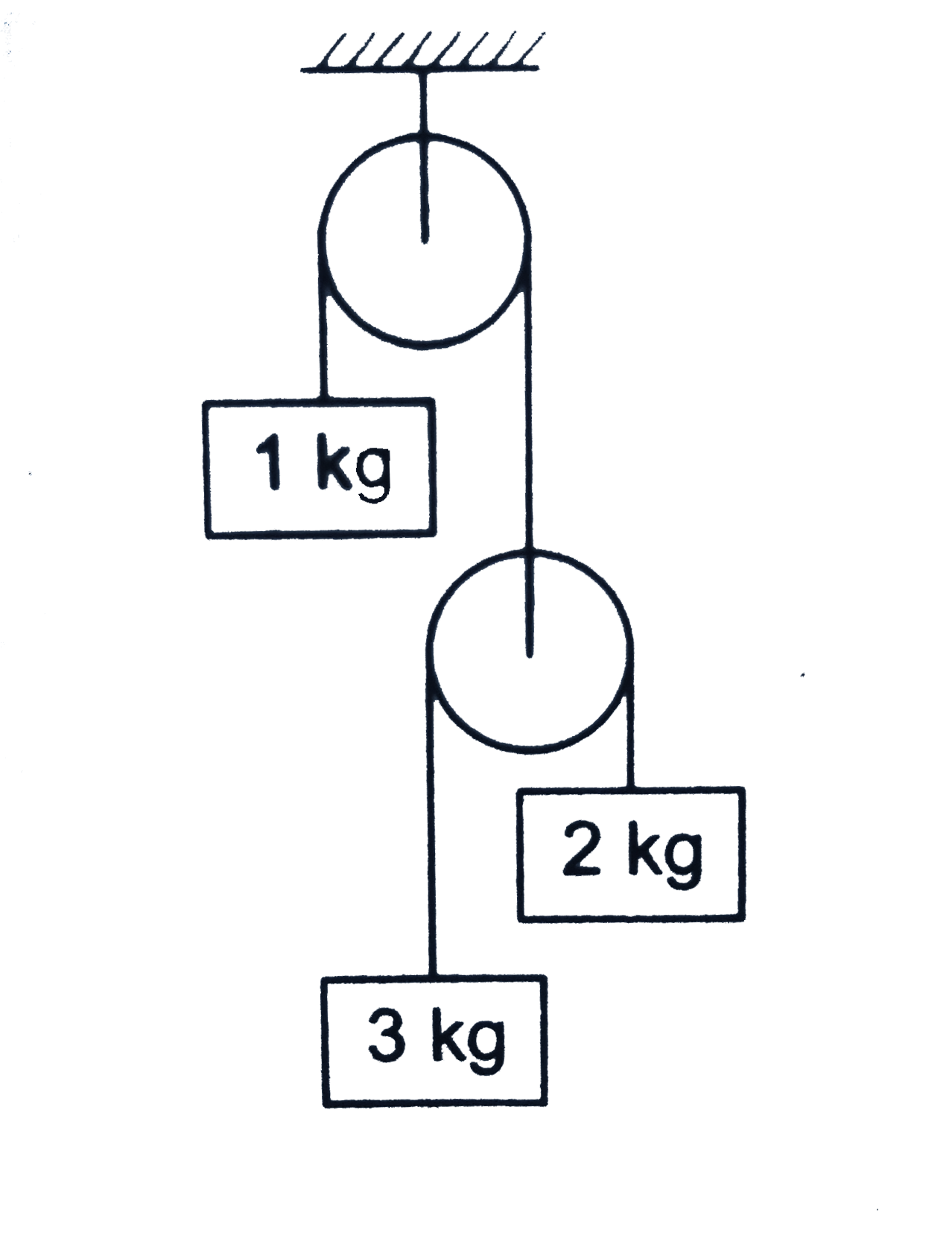
View SolutionAll surface are smooth in following figure. Find `F`, such that block remain stationary with respect to wedge.
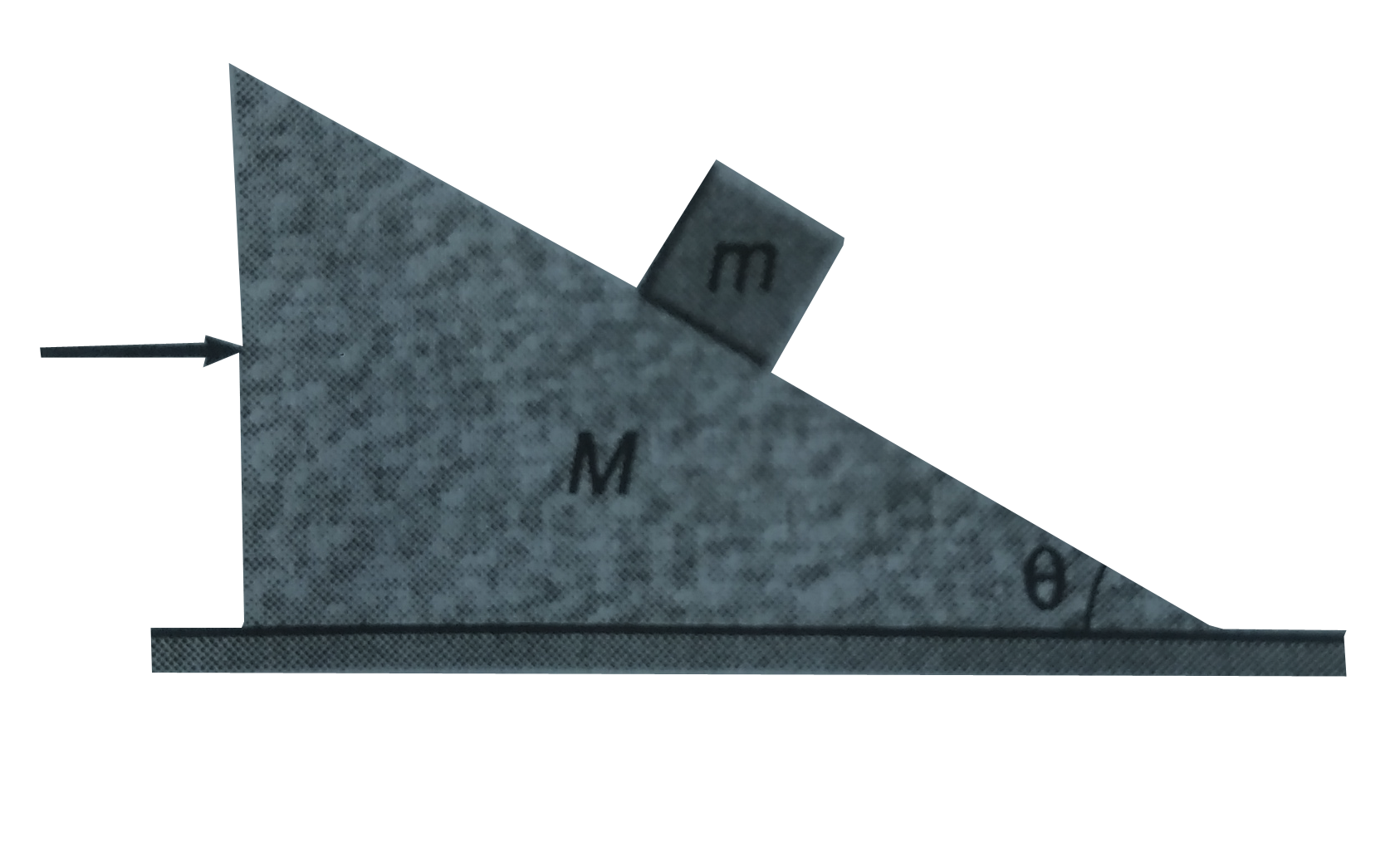
View SolutionA bob of mass `m` is suspended from the ceiling of a train moving with an acceleration a as shown in figure. Find the angle `theta` in equilibrium position.
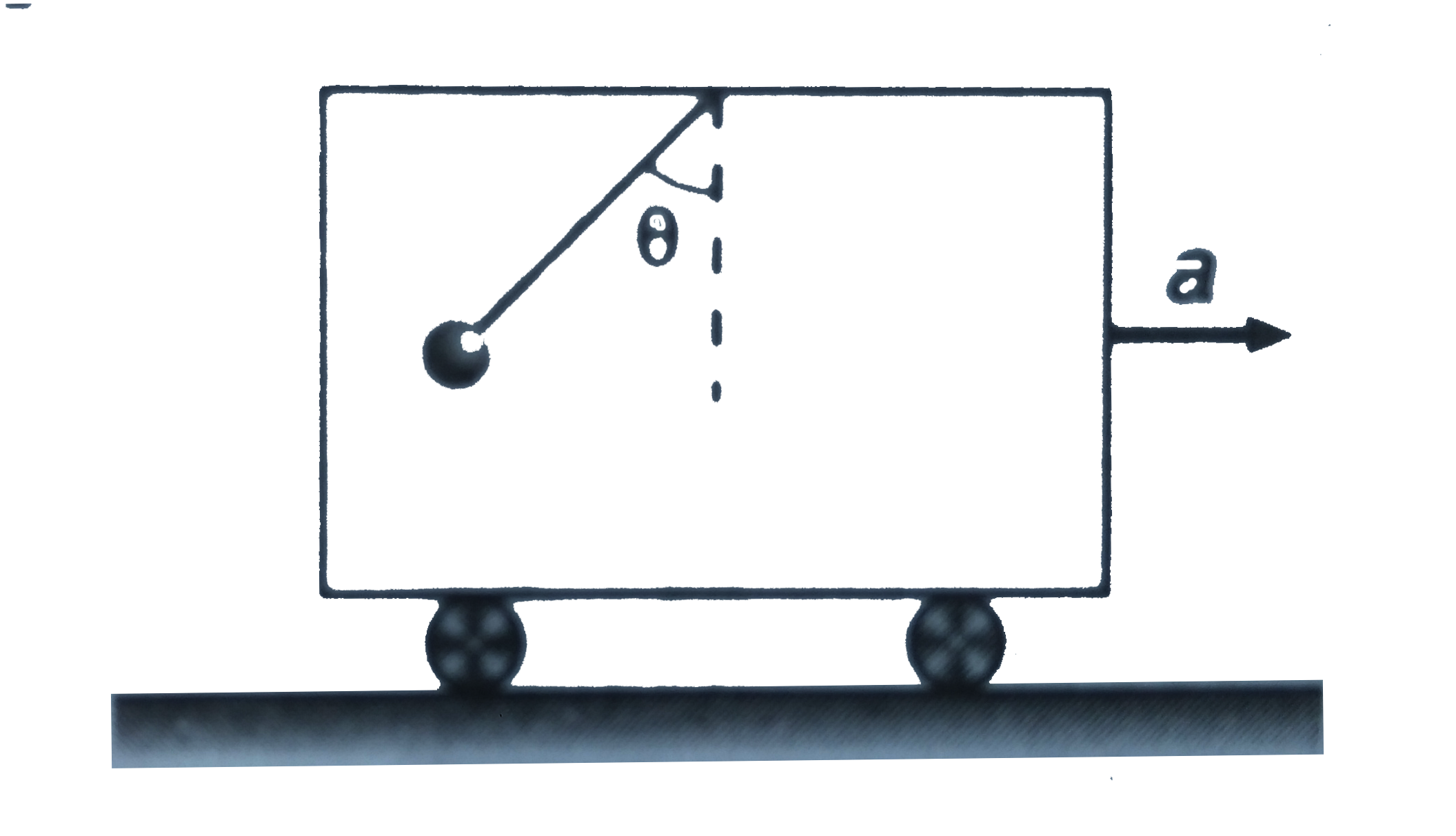
View SolutionSuppose a block of mass `1kg` is placed over a rought surface and a horizontal force `F` is applied on the block as shown in figure. Now let as see what are the values of force of friction `f` and acceleration of the block a if the force `F` is gradually increased. Given that `mu_(s) =0.5,mu_(k) =0.4 and g=10m//s^(2)`
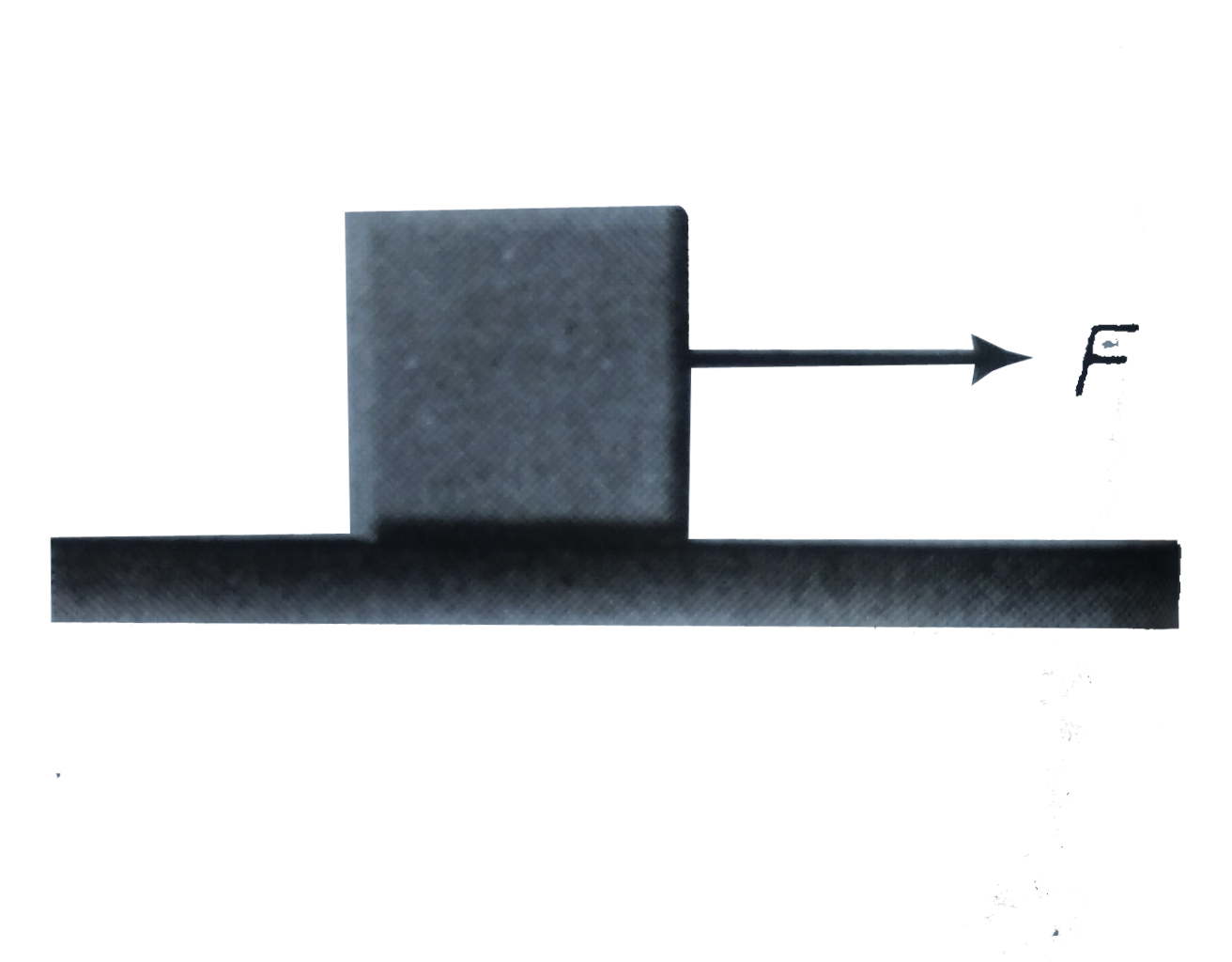
View SolutionA partical of mass `1kg` rests on rought contact with a plane inclined at `30^(@)` to the horizontal and is just about to slip, Find the coefficient of friction between the plane and the particle.
View SolutionIn the adjoining figure, the coefficient of friction between wedge (of mass `M`) and block (of mass `m`) is `mu`.
Find the minimum horizontal force `F` required to keep the block stationary with respect to wedge.

View SolutionFind `V_(A)-V_(B)` in steady state
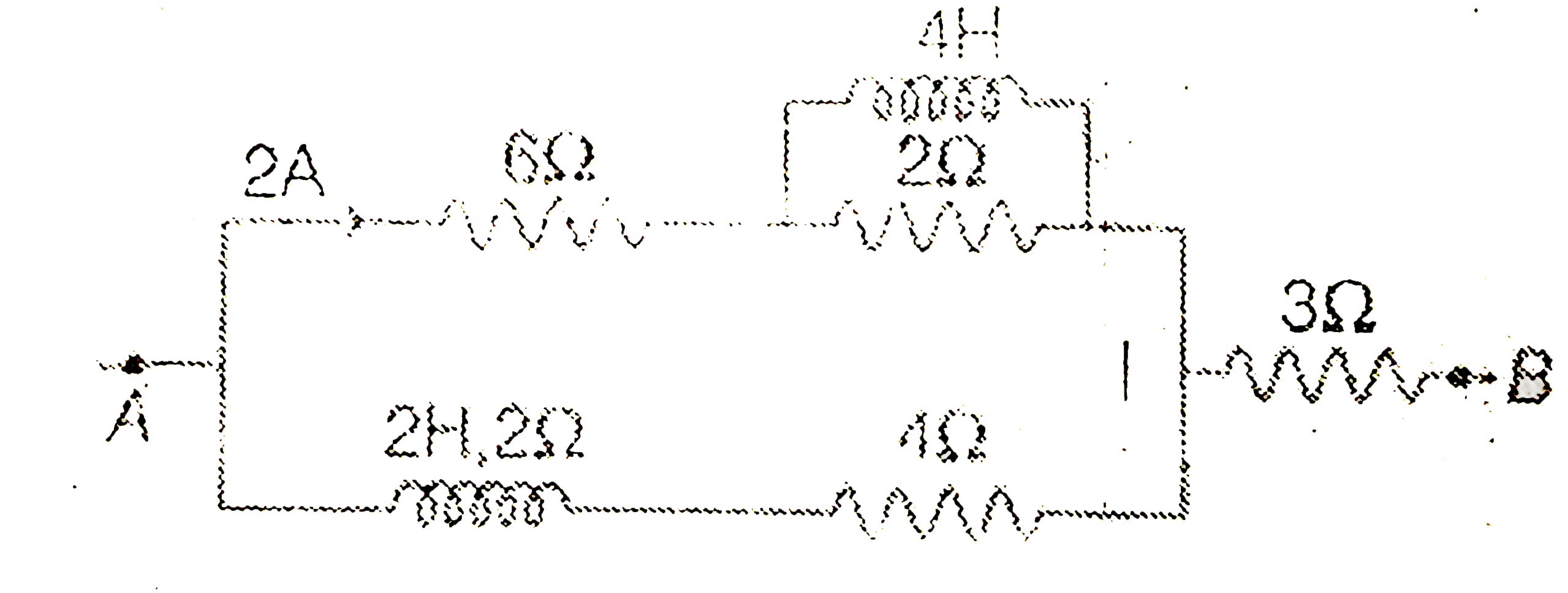
View SolutionA block of mass `m` is at rest on a rought wedge as shown in figure. What is the force exerted by the wedge on the block?
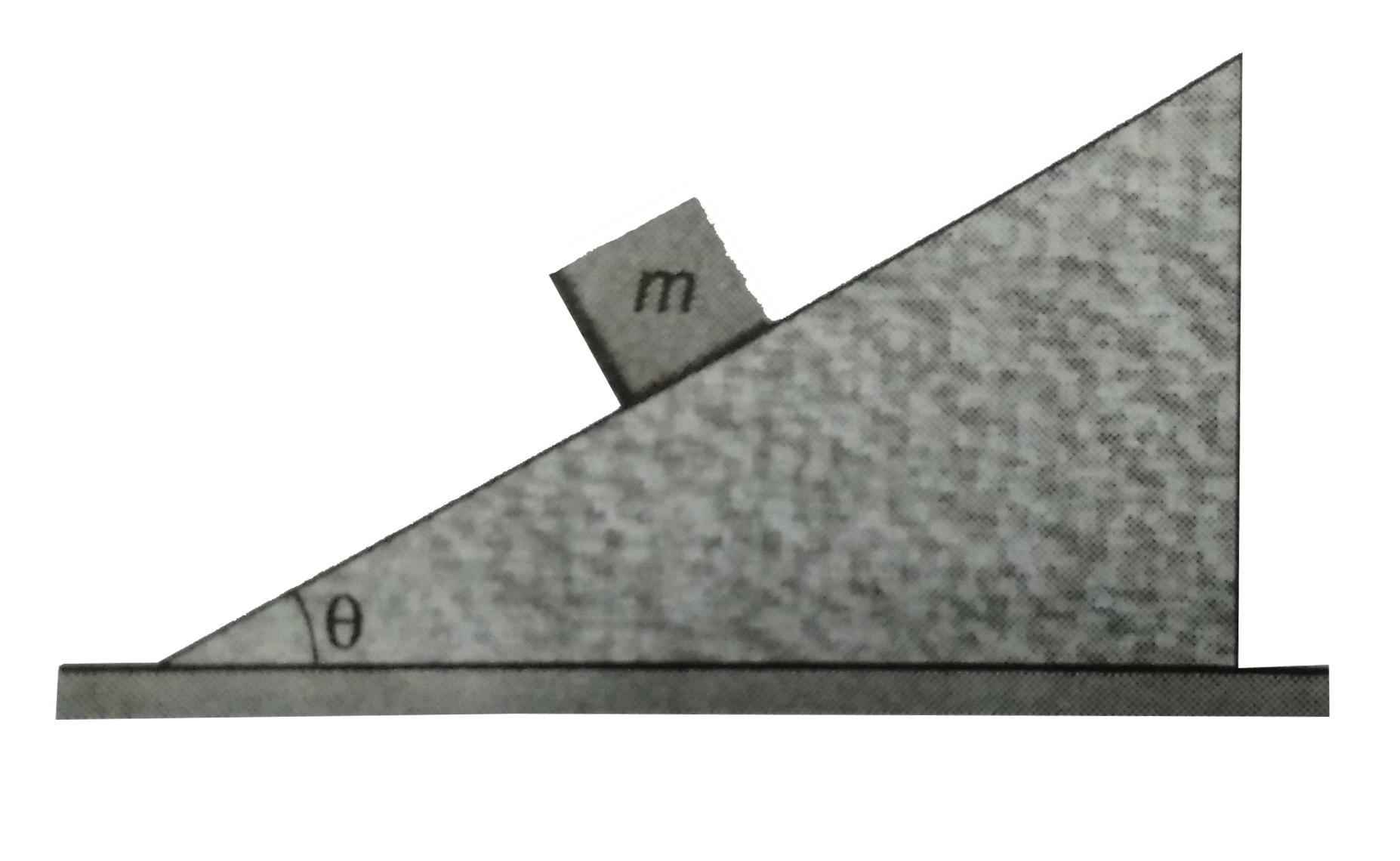
View SolutionIf an electron is subjected to a force of `10^(-25)` N is an X-ray machine, then find out the time taken by the electron to cover a distance of 0.2m. Take mass of the electron `10^(-30)` kg.
View SolutionA bullet of mass 0.06 kg moving with a speed of `90ms^(-1)` enters a heavy wooden block and it stopped after a distance of 60 cm. What is the average resistive force exerted by the block on the bullet ?
View SolutionA stone of mass 1 kg is thrown with a velocity of `20ms^(-1)` across the frozen surface of a lake and it comes to rest after travelling a distance of 50m. What is the magnitude of the force opposing the motion of the stone?
View SolutionA block of metal weighing `2kg` is resting on a frictionless plane . It is struck by a jet of releasing water at the rate of `1 kg s^(-1)` and at a speed of `5ms^(-1)` Calculate the intial acceleration of the blocks .
View SolutionA force of 50N acts in the direction as shown in figure. The block of mass 5kg, resting on a smooth horizontal surface. Find out the acceleration of the block.
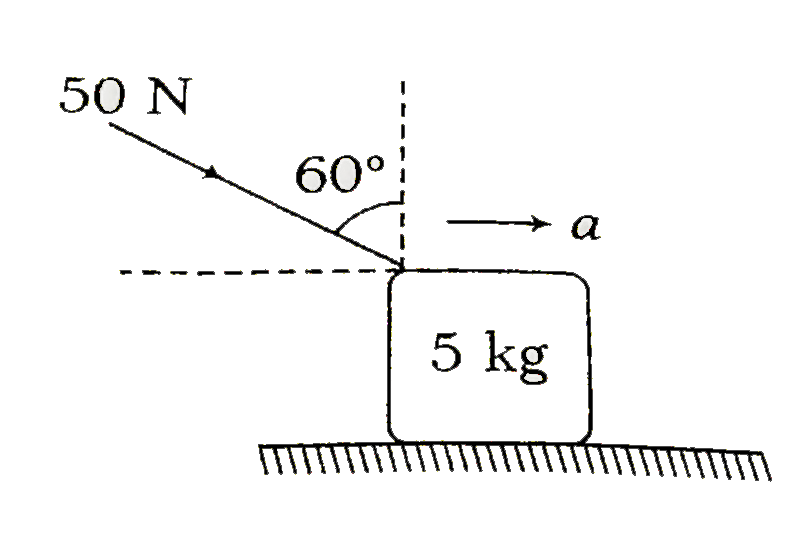
View SolutionA force `F=(6hati-8hatj+10hatk)`N produces acceleration of `sqrt(2) ms^(-2)` in a body. Calculate the mass of the body.
View SolutionA force `F=(2thati+3t^(2)hatj)`N acts on an object moving in XY-plane. Find the magnitude of change in momentum of the object in the time interval t=0 to t=2s.
View SolutionLet us consider two forces `F_(1) " and " F_(2)` acting on a body of mass 2 kg as shown in the figure. `F_(1)=10N`, `F_(2)=`2N , what will be the acceleration?

View SolutionA batsman hits back a ball straight in the direction of the bowler without changing its initial speed of `12 ms^(-1)` . If the mass of the ball is 0.15 kg , determine the impulse imparted to the ball . (Assume linear motion of the ball).
View SolutionA hammer of mass 1 kg moving with speed of `6 ms^(-1)` strikes a wall and comes to rest in 0.1 s . Calculate (i) the impules of force (ii) the retardation of the hammer , and (iii) the retarding that stops the hammer .
View SolutionA cricket ball of mass 150 g is moving with a speed of `12ms^(-1)` and is hit by a bat so that the ball is turned back with velocity of `20ms^(-1)` if duration of contact between bat and ball is 0.01 s then:
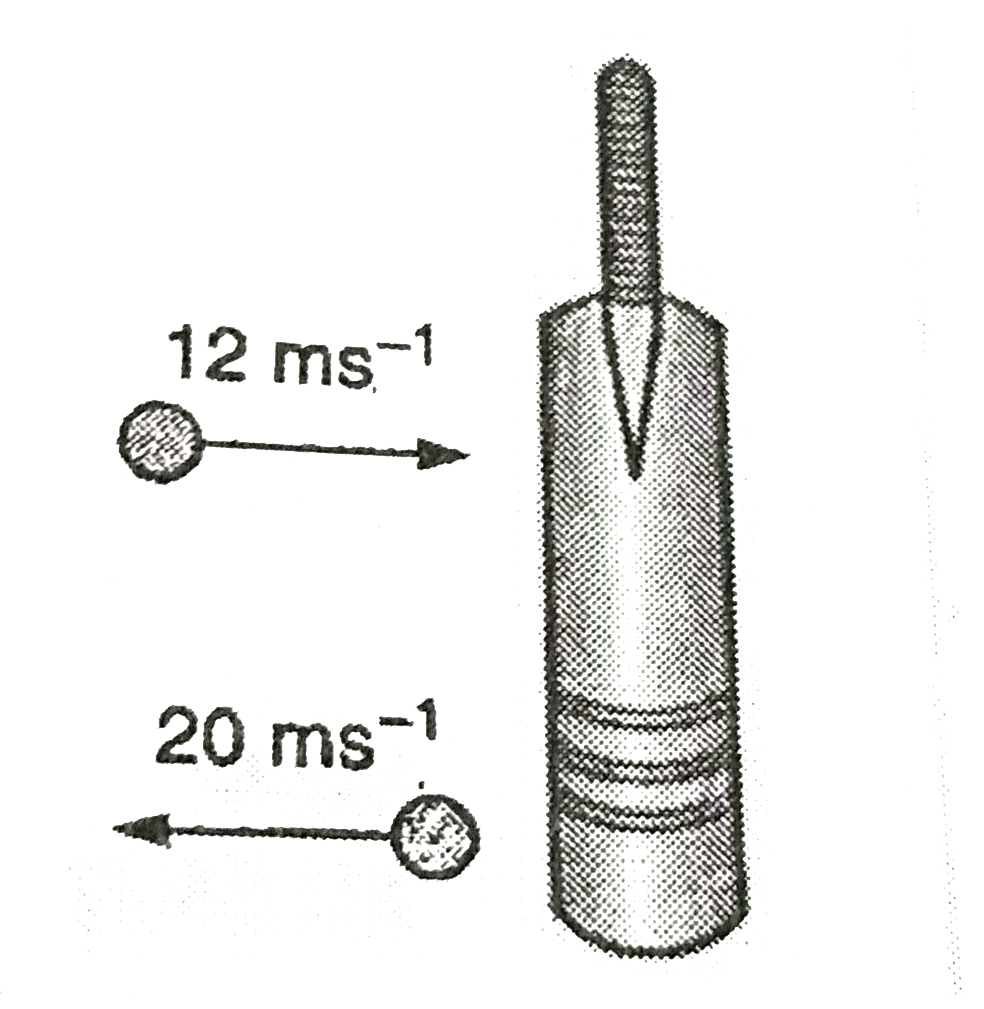
View SolutionFig. shows an estimated force-time graph for a base ball struck by a bat. From this curve, determine
(i) impulse delivered to the ball
(ii) force exerted on the ball
(iii) the maximum force on the ball.
View SolutionA block of mass 25 kg is raised by a 50 kg man in two different ways as shown in Fig. 5.19. What is the action on the floor by the man in the two cases ? If the floor yields to a normal force of 700 N , which mode should the man adopt to lift the block without the floor yielding ?
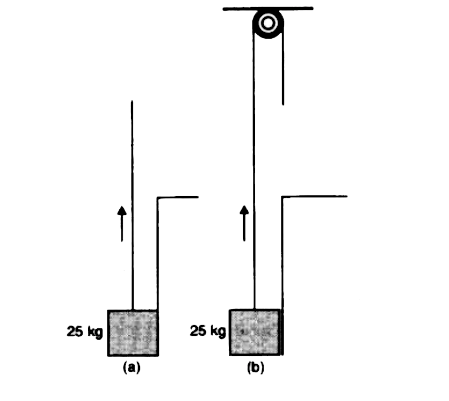
View SolutionA bullet mass 10gm is fired from a gun of mass 1 kg . If the recoil velocity is 5 `m//s`, the velocity of the muzzle is
View SolutionAn explosion blows a rock into three parts. Two parts go off at right angles to each other . These two are `1 kg` first part moving with a velocity of `12 ms^(-1) and 2 kg` second part moving with a velocity of `8 ms^(-1)`. If the third part flies off with a velocity of `4 ms^(-1)`. Its mass would be
View SolutionTwo objects each of mass 5 kg are moving in the same straight line but in the opposite direction towards each other with some speed of 3 m/s. They stick to each other after collision. What will be the velocity of the combined object after collision?

View SolutionA riding ball of mass `m` strikes a rigid wall at `60^(@)` and gets reflected without loss of speed as shown in the figure below. The value of impulse imparted by the wall on the ball will be.
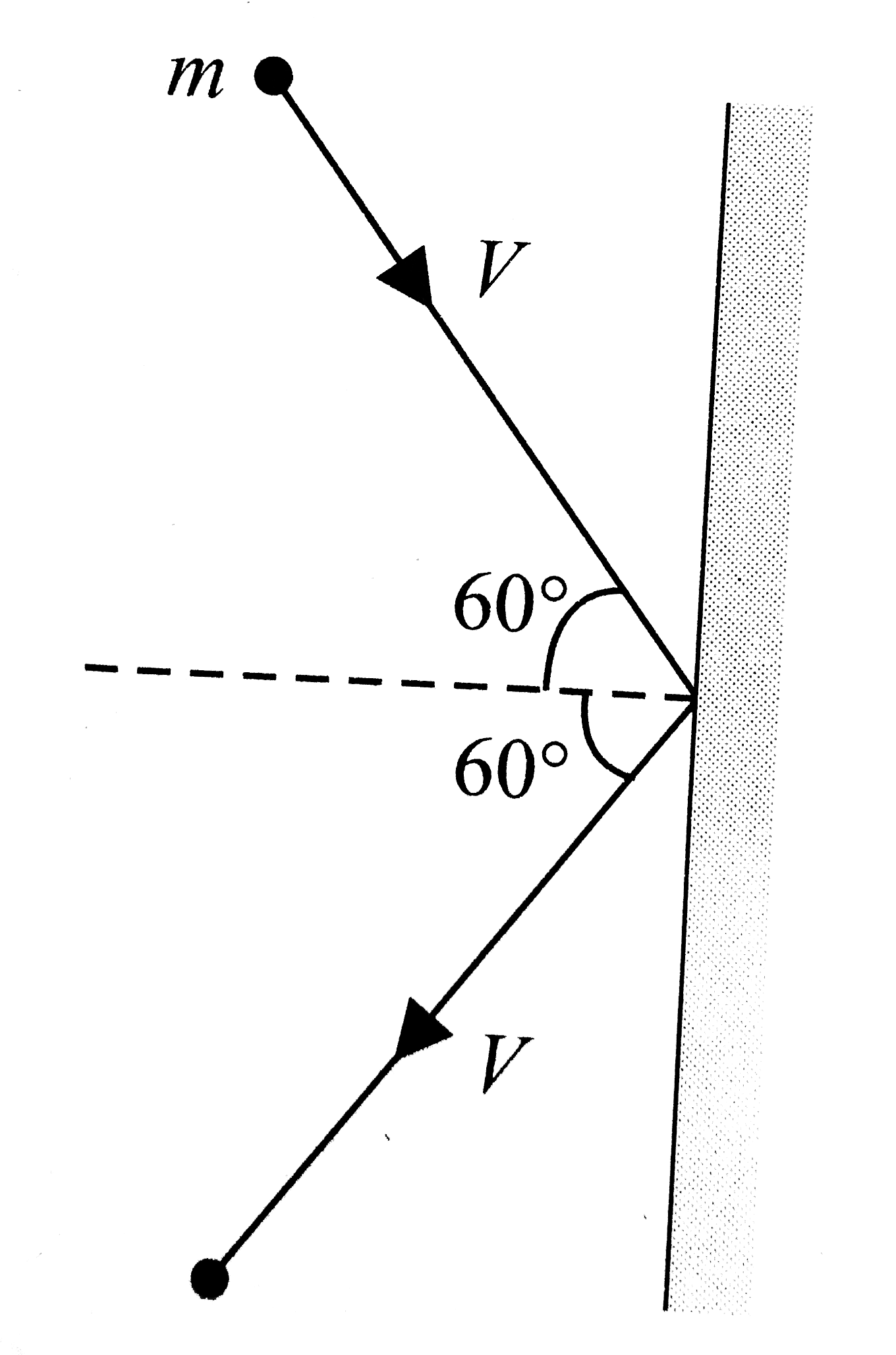
View SolutionResolve horizontally and vertically a force `F= 8N` which makes an angle of `45^(@)` with the horizontal.
View SolutionResolve a weight of 10N in two directions which are parallel and perpendiular to a slope inclined at `30^@` to the horizontal.
View SolutionAn object is in equilibrium under four concurrent forces in the direction shown in figure. Find the magnitudes of `F_(1)` and `F_(2)`

View SolutionDetermine the tensions `T_(1)` and `T_(2)` in the string as shown in figure.
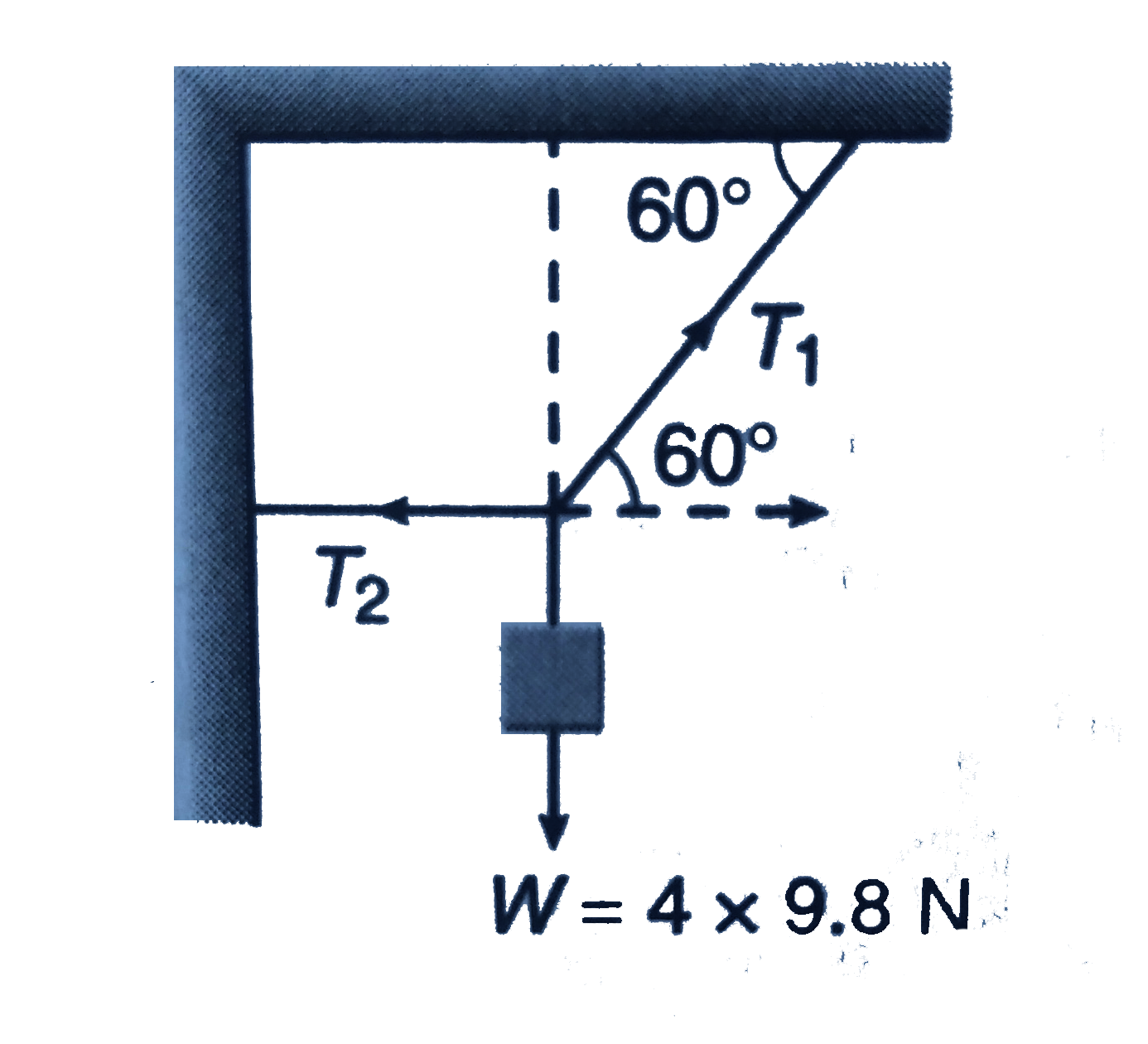
View SolutionOne end of a string `0.5 m` long is fixed to a point `A` and the other end is fastened to a small object of weight `8 N`. The object is pulled aside by a horizontal force F, until it is` 0.3 m` from the vertical through `A`.Find the magnitude of the tension `T` in the string and force `F`.

View SolutionA block of mass `m` is at rest on a rough wedge as shown in figure. What is the force exerted by the wedge on the block?

View SolutionA cylinder of weight `W` is resting on a V-groove as shown in figure .Draw its free body diagram.

View SolutionThree blocks `A,B` and `C` are placed one over the other as shown in figure. Draw free body diagram of all the three blocks.

View SolutionA block of mass `m` is attached with two strings as shown in figure .Draw the free body diagram of the block.

View SolutionAll surfaces are smooth in following figure. Find `F`, such that block remain stationary with respect to wedge.

View SolutionA bob of mass `m` is suspended from the ceiling of a train moving with an acceleration a as shown in figure. Find the angle `theta` in equilibrium position.

View SolutionA spring balance is attached to the ceiling of a lift. A man hangs his bag on the spring and the spring reads 49N, when the lift is stationary. If the lift moves downward with an acceleration of `5m//2^2`, the reading of the spring balance will be
View SolutionIf in a stationary lift, a man is standing with a bucket full of water, having a hole at its bottom. The rate of flow of water through this hole is `R_(0)`. If the lift starts to move up and down with same acceleration and then that rates of flow of water are `R_(u)` and , `R_(d)`, then
View SolutionIn the adjoining figure a wedge is fixed to an elevator moving upwards with an acceleration `a`. A block of mass `m` is placed over the wedge.Find the acceleration of the block with respect to wedge. Neglect friction
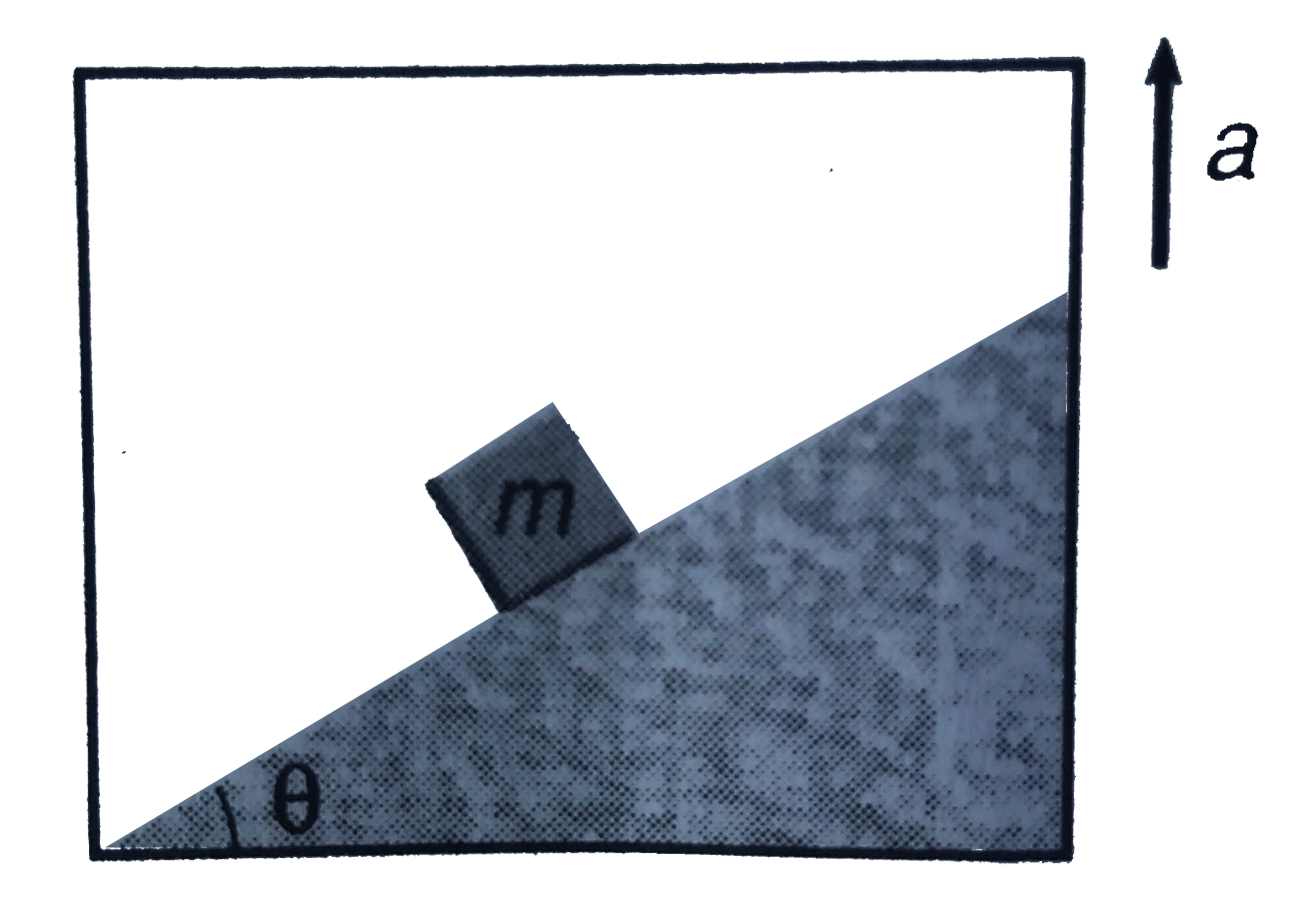
View SolutionTwo blocks of masses `4kg` and `2kg` are placed side on a smooth horizontal surface as shown in the figure. A horizontal force of `20N` is applied on `4kg `block. Find
(a) the acceleration of each block.
(b) the normal reaction between two blocks.

View SolutionThree blocks of masses `3kg ,2kg` and `1kg` are placed side by side on a smooth surface as shown in figure. A horizontal force of `12N` is applied on `3kg` block. Find the net force on `2kg` block.

View SolutionA block of mass M is pulled along a horizontal frictionless surface by a rope of mass m as shown in A horizontal force F is applied to one end of the rope. Find
(a) the acceleration of the rope and block
(b) the force that the rope exerts on the block
(c) the tension in the rope at its mid point
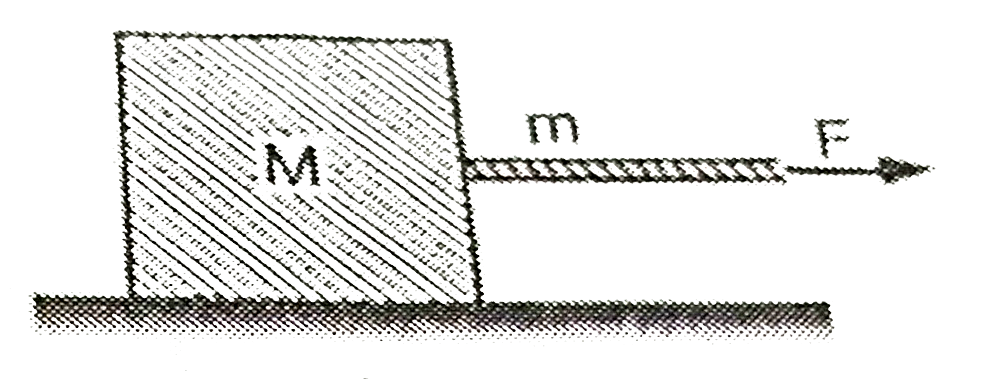
View SolutionIn the arrangement shown in figure, the string are light and intextensible. The surface over which blocks are placed is smooth. Find

(a) the accelrations of the block
(b) the tension in each string.
View SolutionThe blocks of masses `2kg, 3kg` and `5kg` are connected by light inextensible strings as shown. The system of blocks is raised vertically upwards by appling a force `F_(0)=200N`. Find the common acceleration and tensions in the strings.
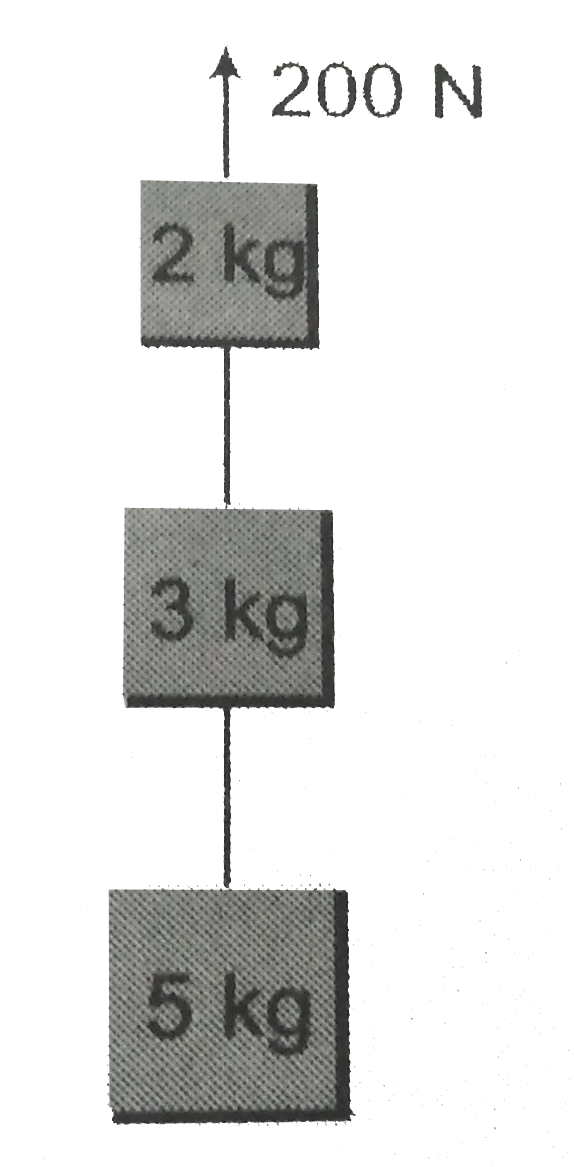
View SolutionTwo block of mass 4 kg and 2 kg are attached by an inextensible light string as shown in figure. Both the blocks are pulled vertically upwards by a force F=120N

Find
(a) the acceleration of the blocks,
(b) tension in the string. (Take g=`10 ms^(-2)`)
View SolutionTwo spheres of masses 2.6 kg and 4.1 kg are tied together by a light string looped over a frictionless pulley.
(i) What will the acceleration of each mass be?
(ii) Find the value of tension in the string.
View SolutionThe pulley is light and smooth`:` the strings are inextensible and light. The system is released from rest, find the acceleration of each block, tensions in the strings and reaction in pulley.
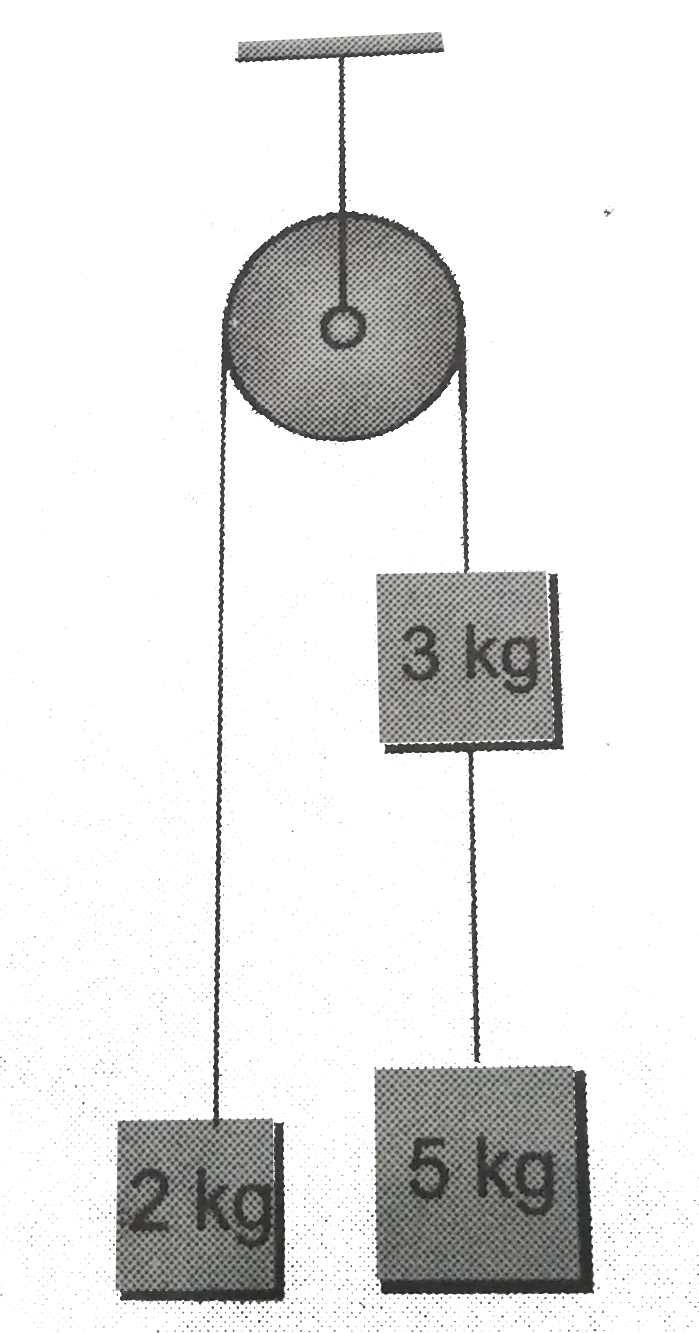
View SolutionA 2 kg mass placed on a level table and is attached by a string passing over the edge of a table as illustrated in the diagram.
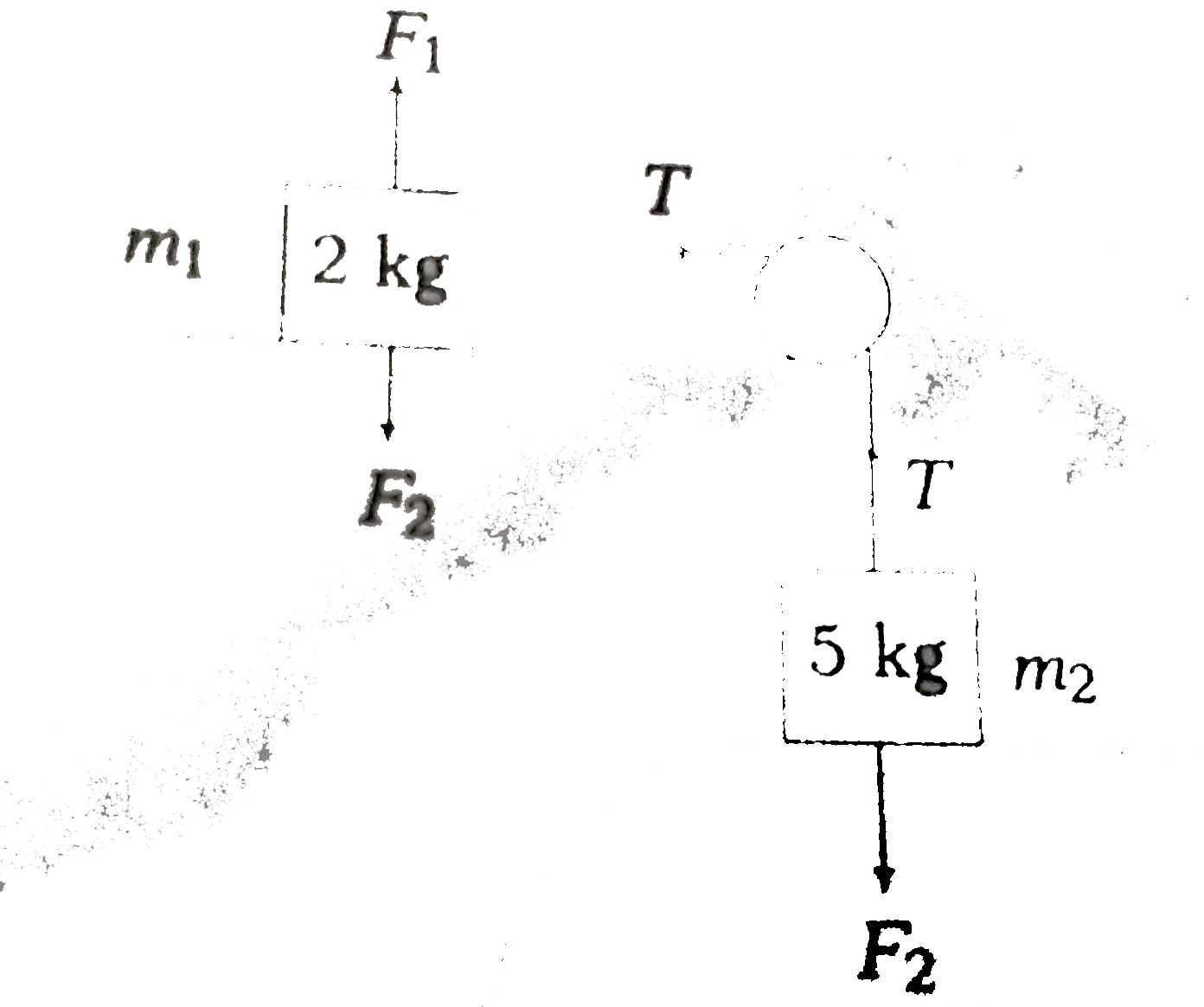
(i) Calculate the magnitude of acceleration of the system.
(ii) Calculate the tension in the string.
View SolutionA 3000 kg truck is on a cliff and is tied with a rope to a 78 kg person hanging over the cliff. If the cliff is very icy ( frictionless), what is the magnitude of acceleration of the system?
View SolutionThe strings are inextensible and light`:` the pulleys are smooth and light. Find the acceleration of each block and tensions in the strings.
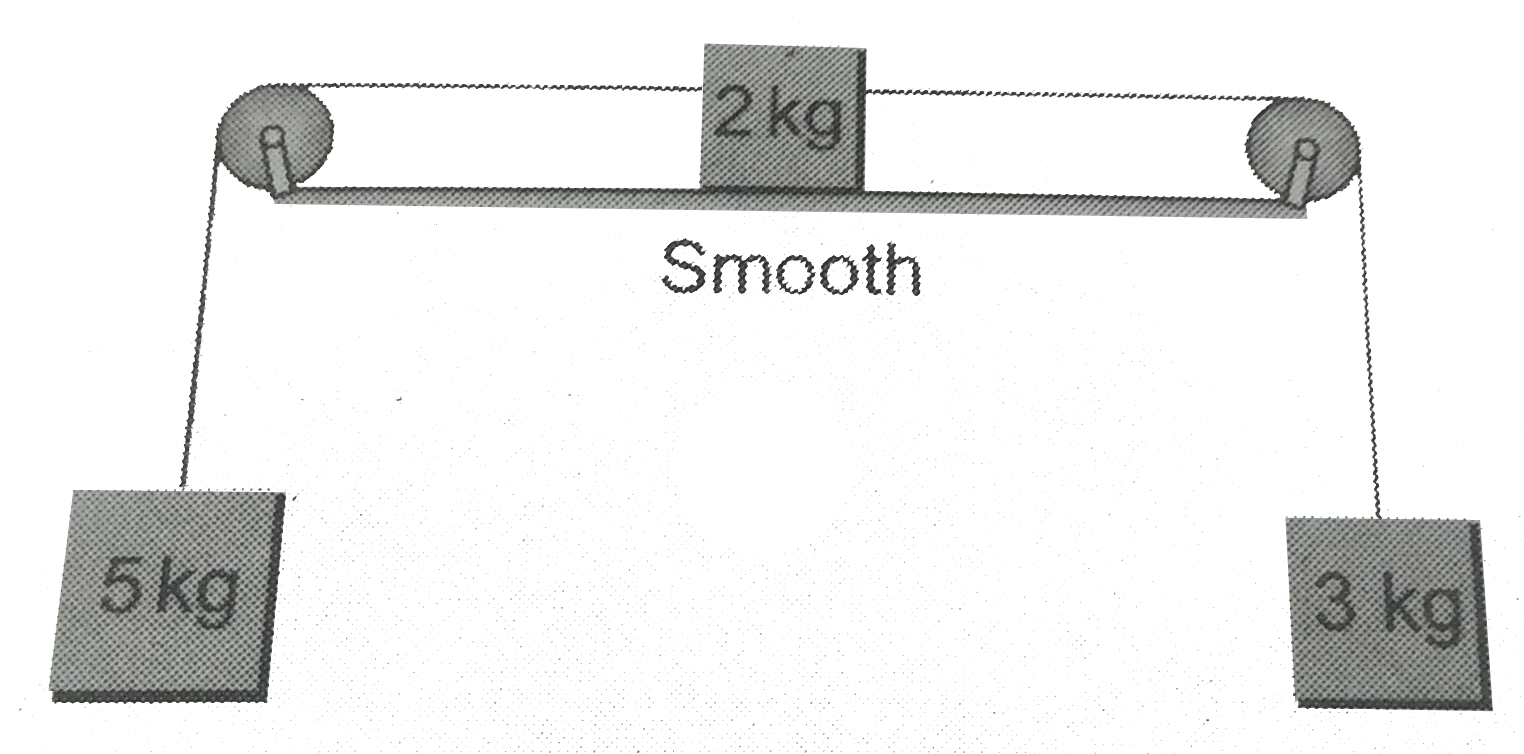
View SolutionConsider the situation shown in the figure. The surface is smooth and the string and the pulley are light. Find the acceleration of each block and tension in the string.
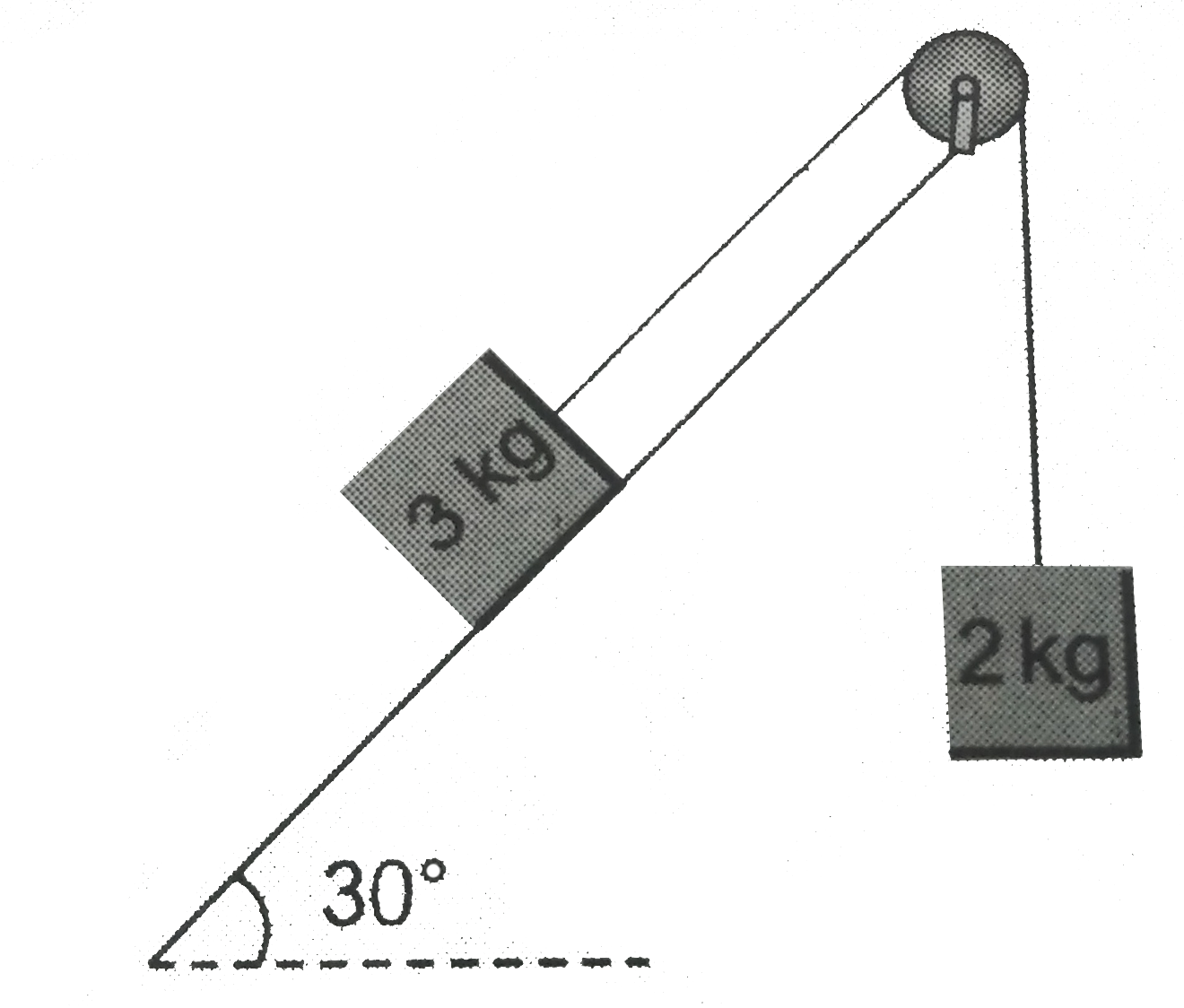
View SolutionIn the arrangement shown, inclined plane is smooth, strings and pulleys are massless. Find `T_(1)/T_(2)`
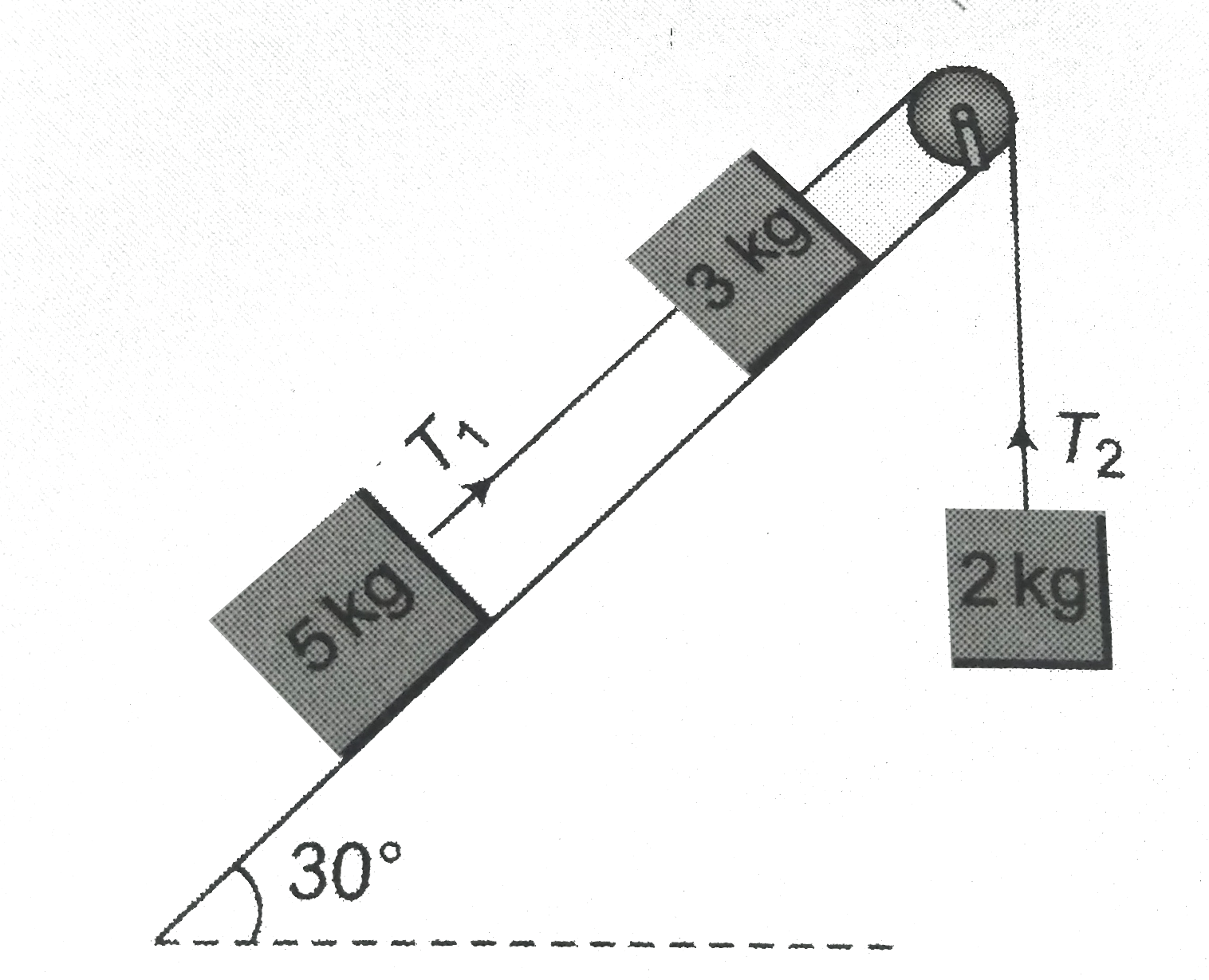
View SolutionIn the arrangement shown, all the surface are smooth, strings and pulleys are light. Find the tension in the string.
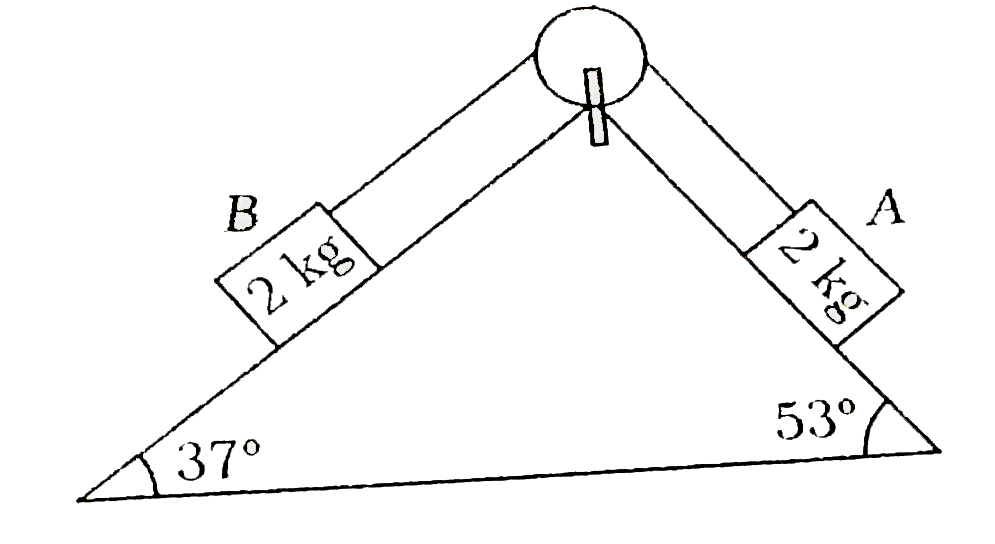
View SolutionIn the adjacent figure, mass of A, B and C are 1 kg , 3 kg and 2 kg, respectively. Find
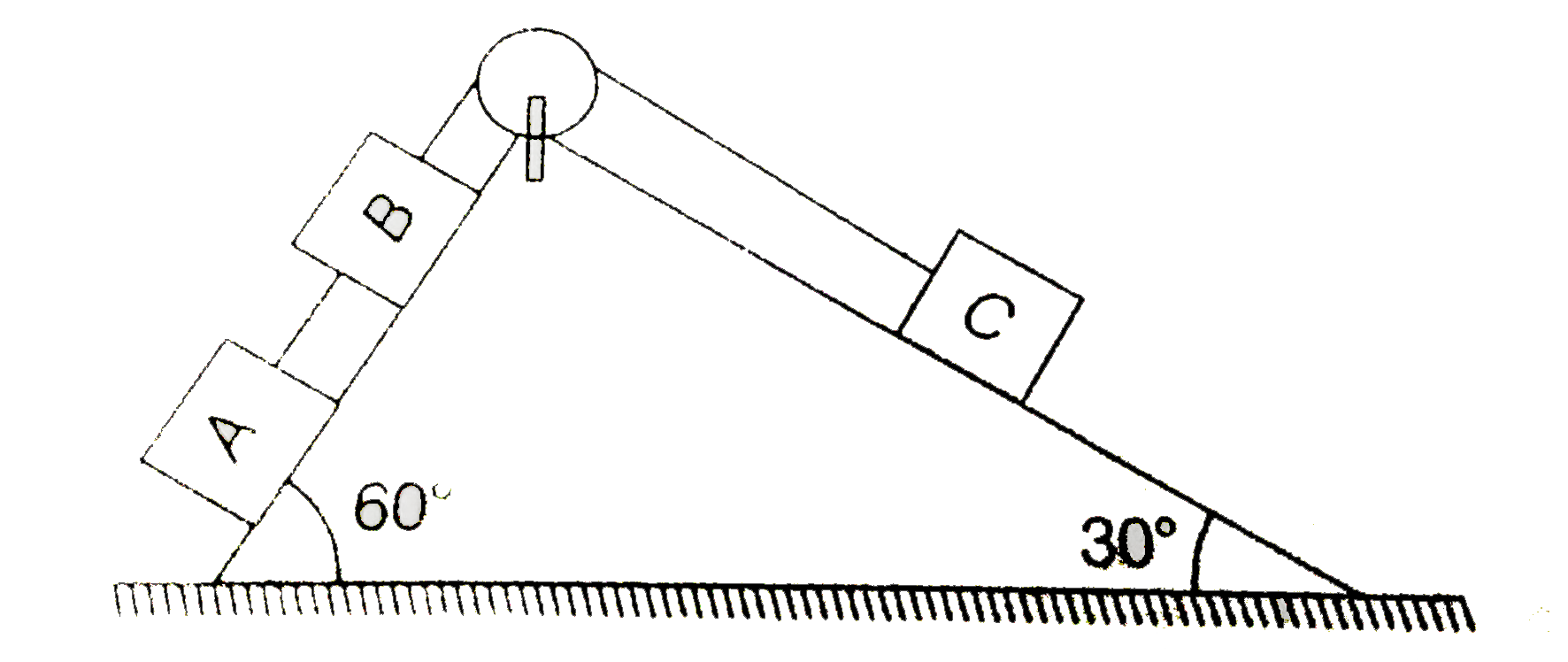
(a) the acceleration of the system, and
(b) tensions in the string .
Neglect friction. (g`=10ms^(-2)`)
View SolutionCalculate the net acceleration produced in the arrangement shown below.
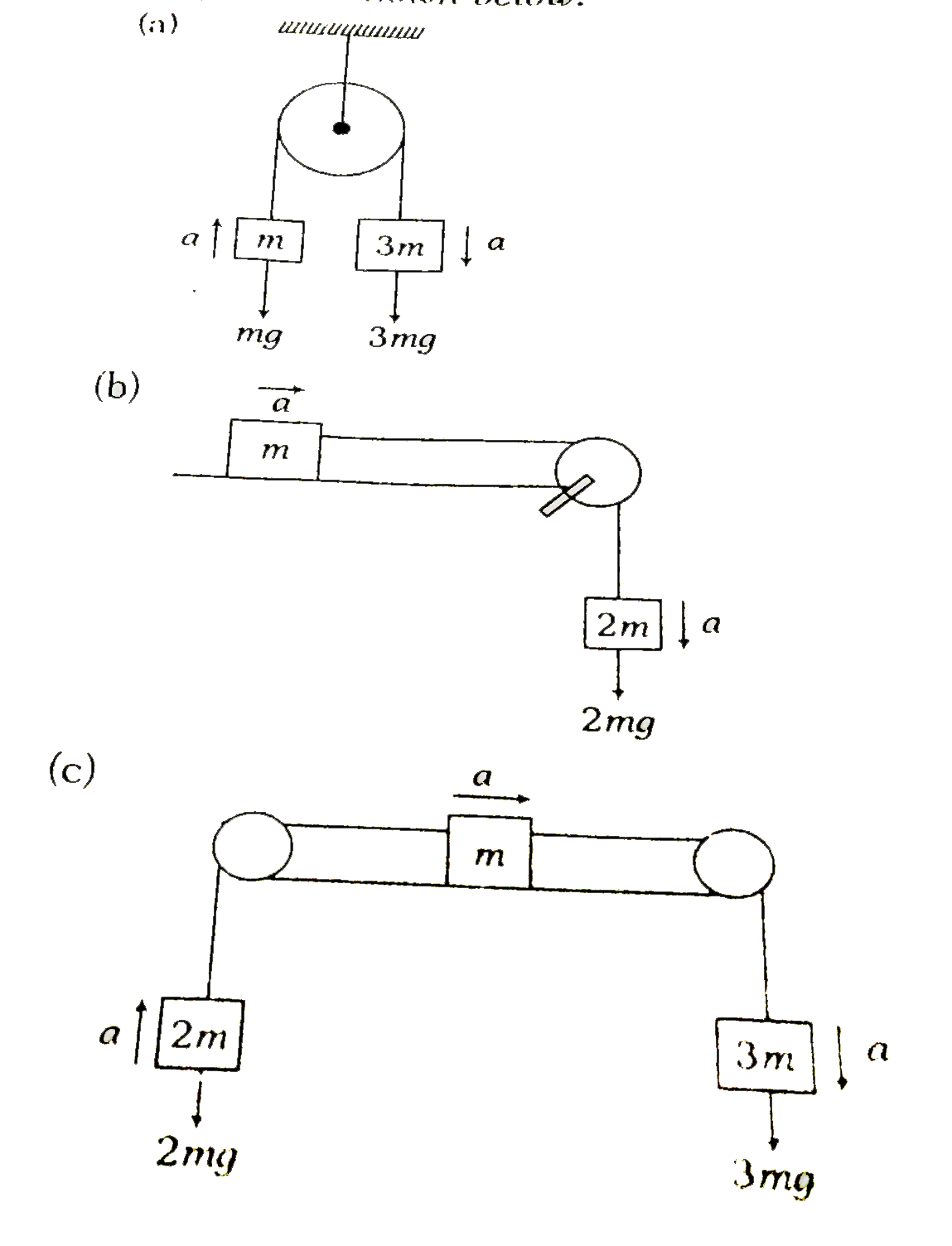
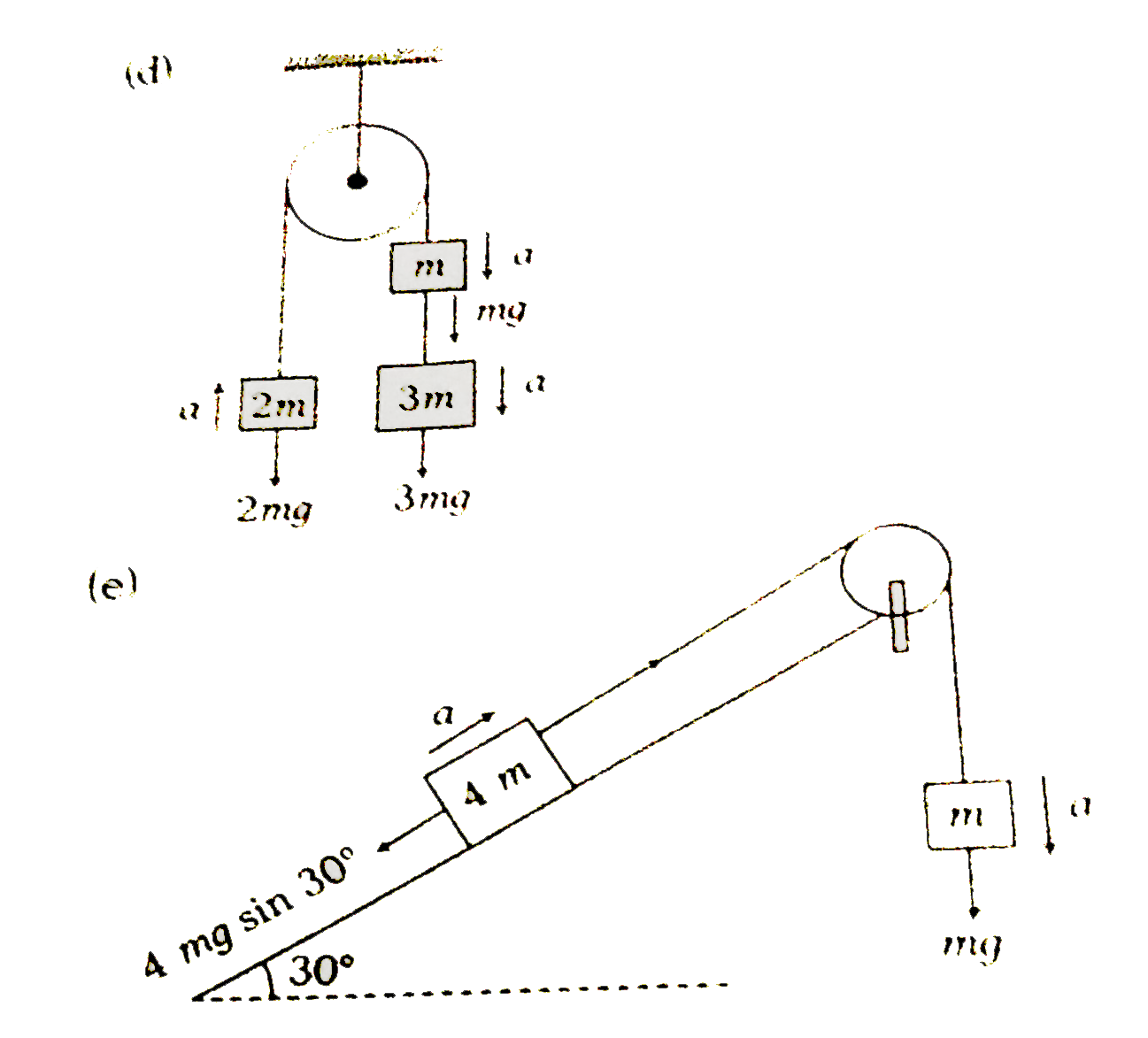
View SolutionSuppose a block of mass `1kg` is placed over a rough surface and a horizontal force `F` is applied on the block as shown in figure. Now, let us see what are the values of force of friction `f` and acceleration of the block a if the force `F` is gradually increased. Given that `mu_(s) =0.5,mu_(k) =0.4 and g=10m//s^(2)`

View SolutionBlock A and B of masses 5 kg and 10 kg are placed as shown in figure. If block A is pulled with 50 N. Find out acceleration of the A and B. If coefficient of friction between A and B is 0.5 and between B and ground is 0.4.
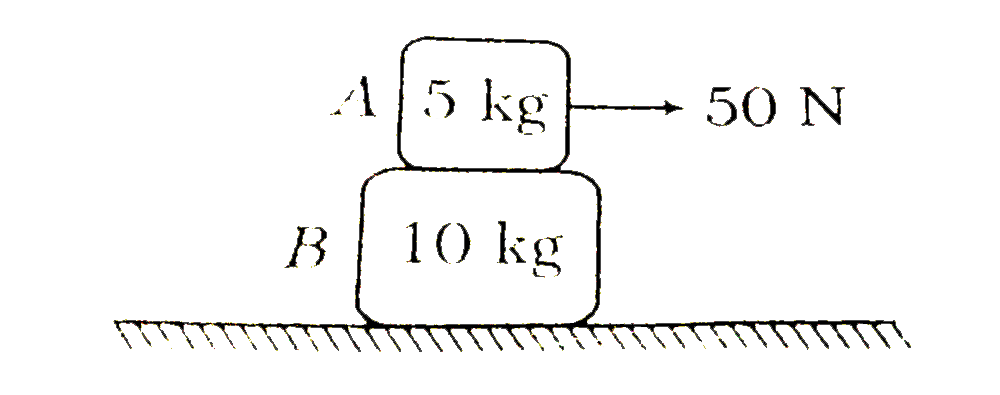
View SolutionA block A of mass 4 kg is placed on another block B of mass 5 kg , and the block B rests on a smooth horizontal table . For sliding block A on B , a horizontal force of 12 N is required to be applied on A How much maximum force can be applied on B so that both A and B move togrther ? Also find out acceleration produced by this force .
View SolutionA body of mass 10 kg is kept on a horizontal floor of coefficent of static friction `mu_(s)=0.5` and coefficient of kinetic friction `mu_(k)=0.45` as shown in figure.
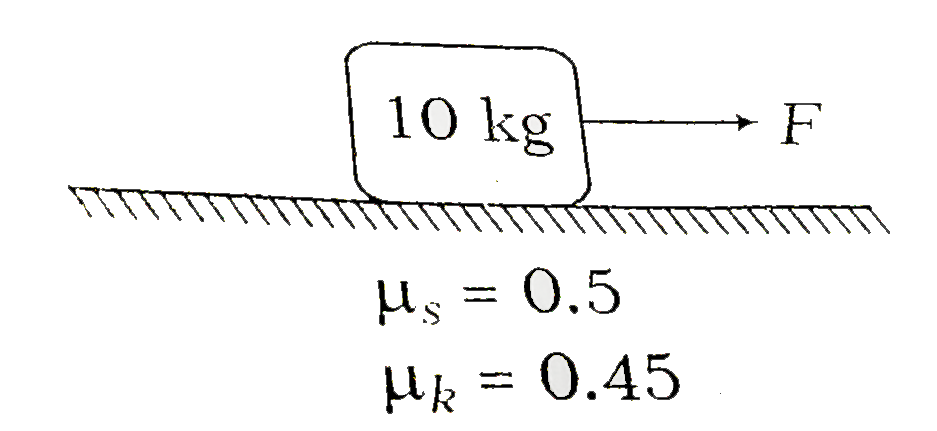
Find the acceleration, force of friction and contact force on the body by the plane when the driving force is `(g=10ms^(-2))`
(i) 40 N (ii)60N
View SolutionIn the adjoining figure, the coefficient of friction between wedge (of mass `M`) and block (of mass `m`) is `mu`.
Find the minimum horizontal force `F` required to keep the block stationary with respect to wedge.

View SolutionIf the coefficient of friction between an insect and bowl is `mu` and the radius of the bowl is r, find the maximum height to which the insect can crawl in the bowl.
View SolutionA block of mass 5 kg rests on a inclined plane at an angle of `30^(@)` with the horizontal. If the block just begins to slide, then what is the coefficient of static friction between the block and the surface?
View SolutionA block of wood of 1 kg resting on an inclined plane of angle `30^(@)`, just starts moving down. If the coefficient of friction is 0.2, then find its velocity (in `ms^(-1)`) after 5 s (take , `g=10ms^(-2)`)
View Solution`A` rod `AB` rests with the end `A` on rough horizontal ground and the end `B` against a smooth vertical wall. The rod is uniform and of weight w. If the rod is in equilibrium in the position shown in figure.Find
(a)frictional force shown at `A`
(b) normal reaction at `A`
(c) normal reaction at `B`.

View SolutionA 4m long ladder weighing 25 kg rests with its upper end against a smooth wall and lower end on rough ground. What should be the minimum coefficient of friction between the ground and the ladder for it to be inclined at `60^@` with the horizontal without slipping? (Take `g = 10 m s^(-2)`)
View SolutionA block of mass `1kg` is pushed against a rough vertical wall with a force of `20N`, coefficient of static friction being `(1)/(4)` Another horizontal force of `10N` is applied on the block in a direction parallel to the wall. Will the block move? If yes, in which direction ? If no, find the frictional force exerted by the wall on the block. `(g = 10m//s^(2))`
View Solution
Example questions and complete solutions for chapter LAWS OF MOTION of DC PANDEY ENGLISH of Class 11
All Exercises from DC PANDEY Class 11 PHYSICS LAWS OF MOTION
- Assertion And Reason
- Chapter exercises (A) Taking it together
- Check point 5.1
- Check point 5.2
- Check point 5.3
- Check point 5.4
- Comprehension
- Example
- Exercise 8.1
- Exercise 8.2
- Exercise 8.3
- Exercise 8.4
- Exercise 8.5
- Match the columns
- Medical entrances gallery
- Miscellaneous Examples
- Objective Question
- Single Correct
- Solved Examples
- Subjective Question